FREE 2 DAY DELIVERY ON ORDERS $399+


The Mix 'n Match Method For Smart Photo Safari Shooting
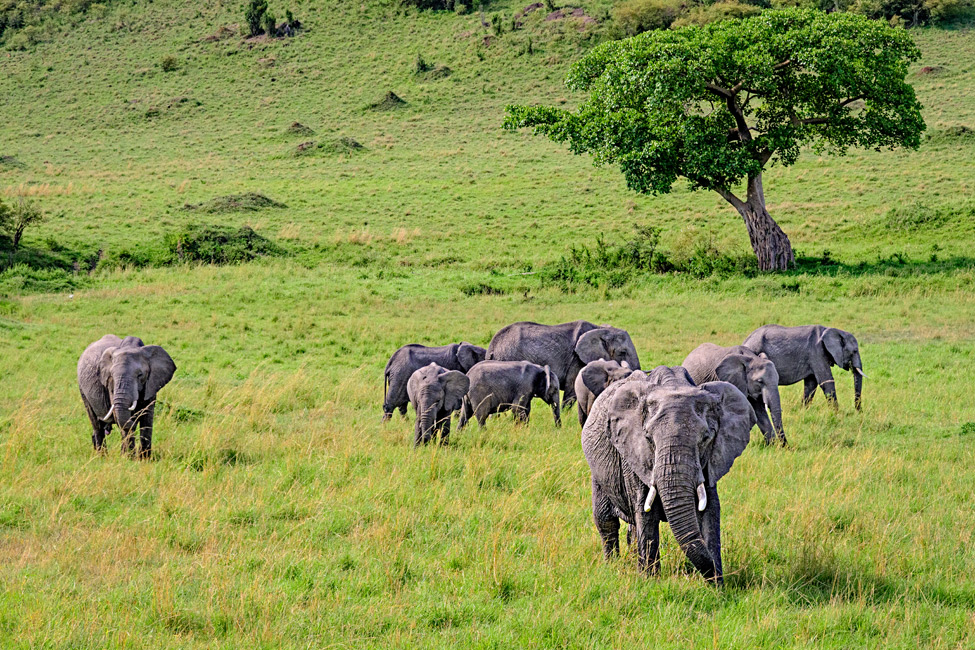
© Mark Alberhasky
In the Masai Mara reserve. "When elephants pass in herds there's often one supervisor-type who wants to take a closer look at what's going on." D500, AF-S DX NIKKOR 16-80mm f/2.8-4E ED VR, 1/1000 second, f/9.5, ISO 800, manual exposure, Matrix metering.
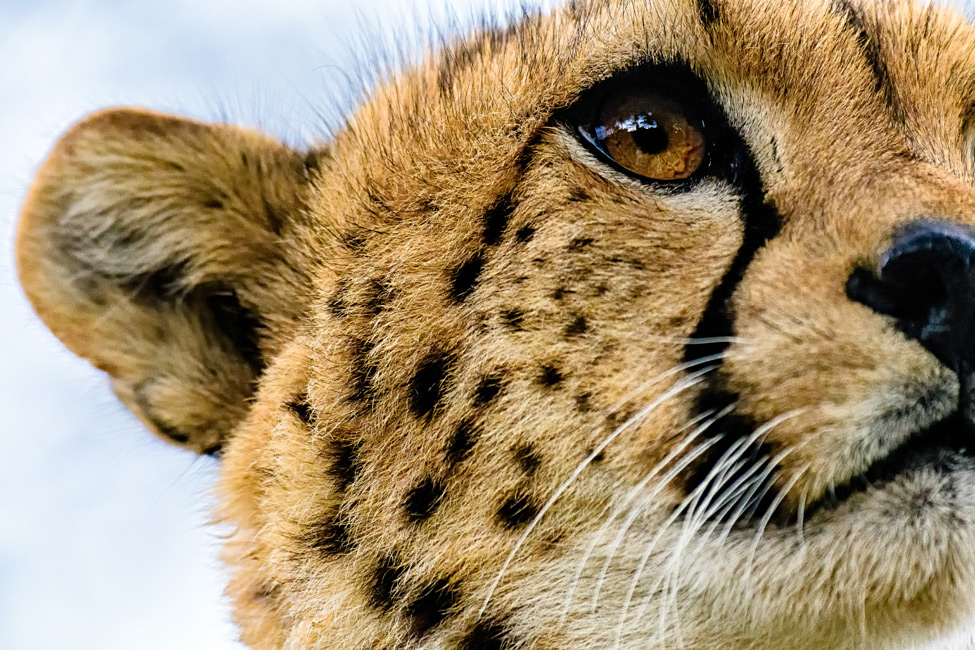
"Cheetahs are one of the few predatory cats for which proximity is generally not dangerous for humans," Mark says. "We're just not on their menu." Still, he used his 80-400mm lens at 400mm for the image, taken in the Nanyuki region of Kenya. D500, AF-S NIKKOR 80-400mm f/4.5-5.6G ED VR, 1/1000 second, f/5.6, ISO 4500, shutter priority, Matrix metering.

"How could five random acacia trees in Masai Mara National Reserve line up in such perfect symmetry? A photo safari is such a visually rich experience, the challenge is not stopping to photograph every 50 feet." D500, AF-S DX NIKKOR 16-80mm f/2.8-4E ED VR, 1/500 second, f/5.6, ISO 1600, shutter priority, Matrix metering.
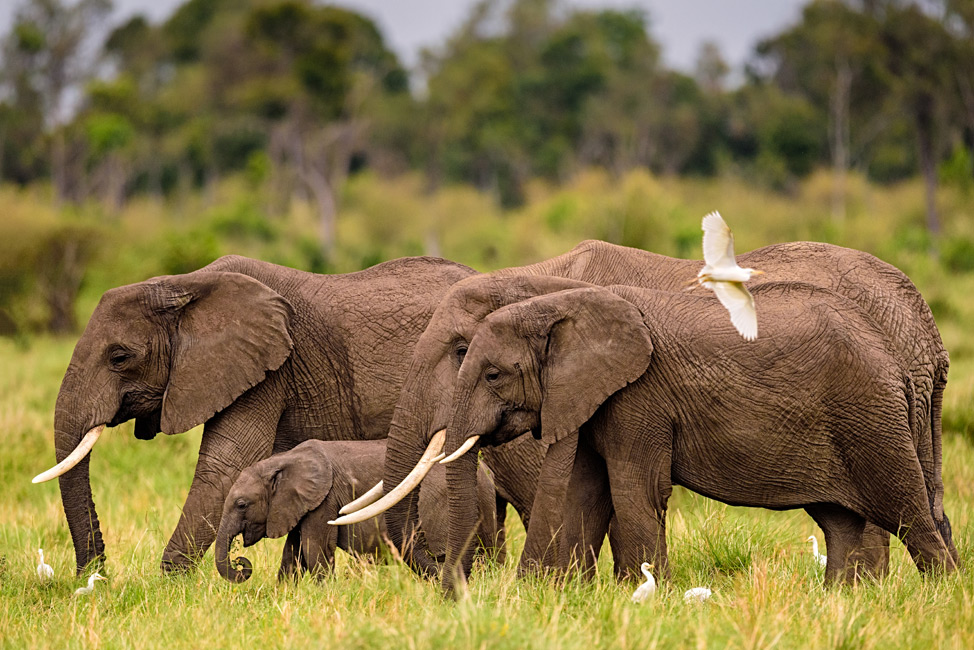
"The young are always protected by their elders," Mark says, "but man needs to protect the elders." This image, taken in Masai Mara, reminds us that if we want to catch a bird in flight, 1/2000 second is a good minimum starting point. D810, AF-S NIKKOR 800mm f/5.6E FL ED VR, 1/2000 second, f/5.6, ISO 1600, shutter priority, center-weighted metering.
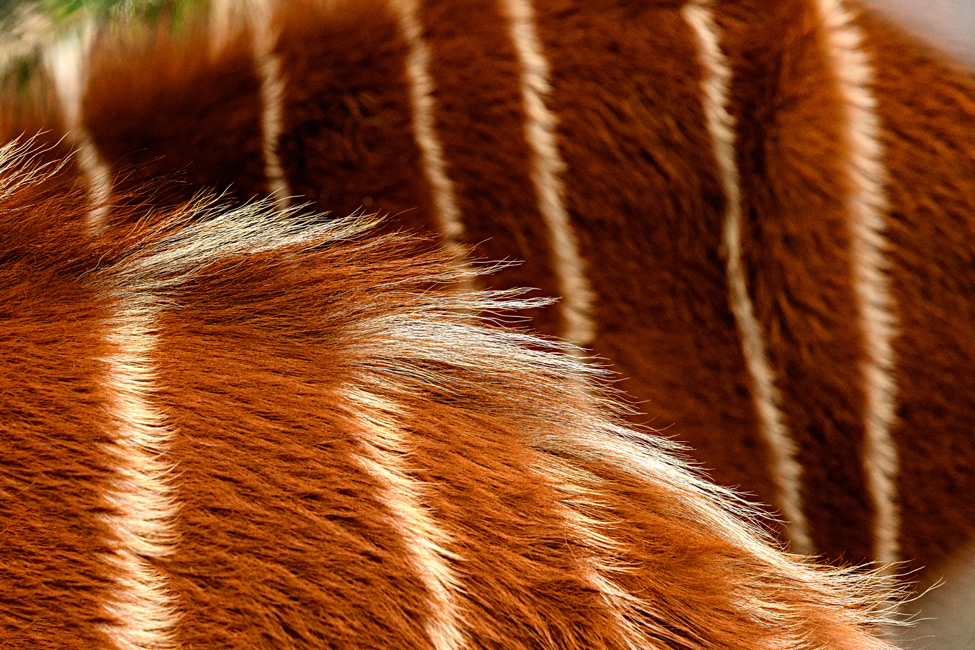
How close you get to animals in Africa is a matter of common-sense caution and a guide's advice. Mark was arm's length from a mountain bongo (a species of antelope) for this closeup in Kenya's Nanyuki region. D500, AF-S DX NIKKOR 16-80mm f/2.8-4E ED VR, 1/500 second, f/6.7, ISO 1600, shutter priority, Matrix metering.
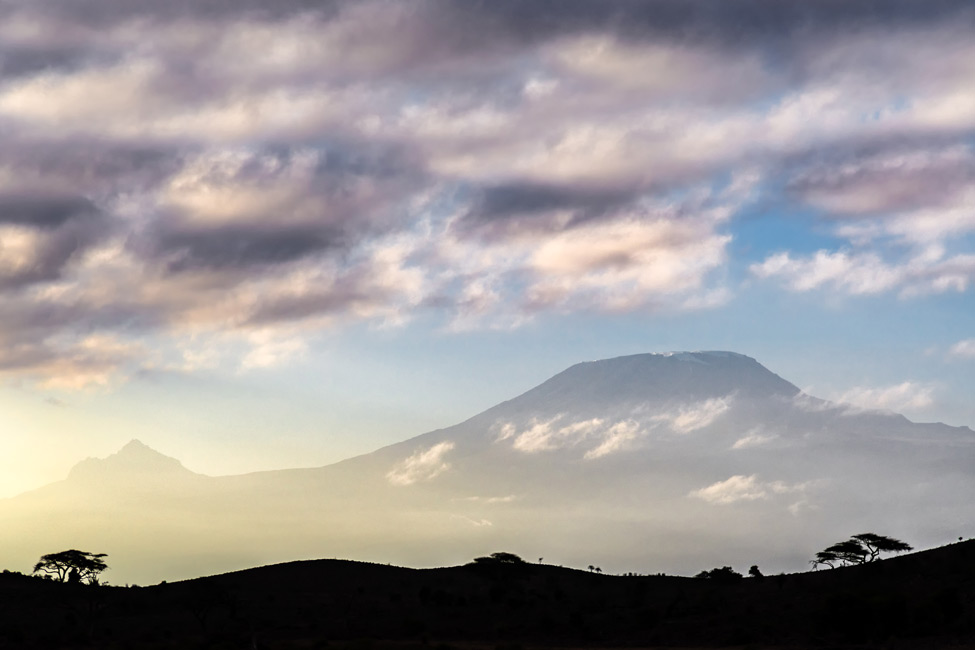
Sunrise on the slopes of Mount Kilimanjaro, looking south across the Kenyan border into Tanzania. D500, AF-S DX NIKKOR 16-80mm f/2.8-4E ED VR, 1/350 second, f/8, ISO 100, manual exposure, Matrix metering.

In Amboseli National Park, Kenya. "Elephant trunks contain over 400,000 muscles, can lift over 700 pounds and yet end in the delicate equivalent of fingers with amazing dexterity." D500, AF-S NIKKOR 800mm f/5.6E FL ED VR, 1/2000 second, f/8, ISO 560, manual exposure, Matrix metering.
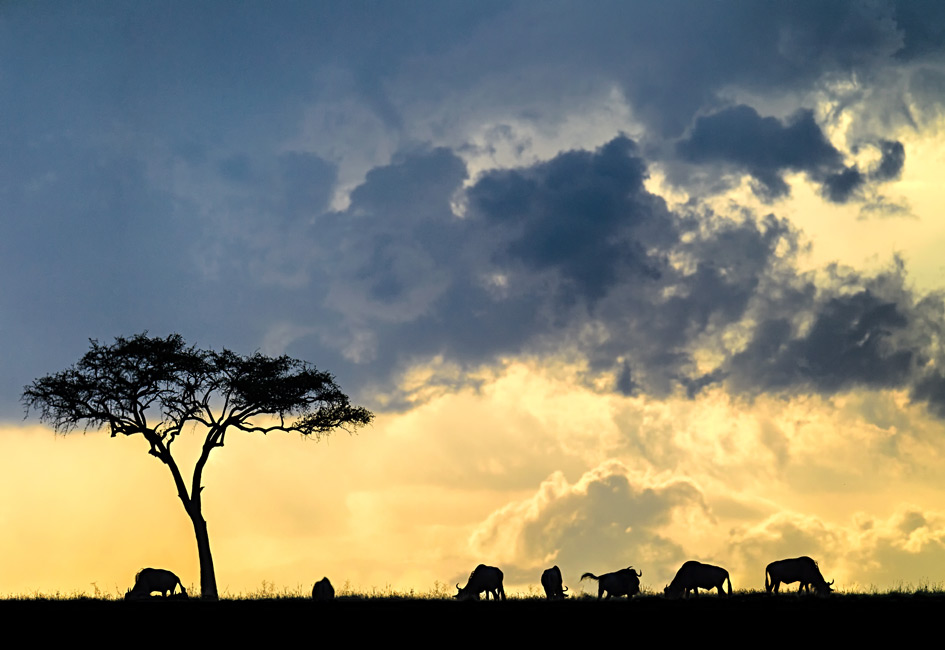
"Gold in the Masai Mara sky drew my eye. and the 800mm lens let me savor the clouds and color on the horizon with incredible detail." D5, AF-S NIKKOR 800mm f/5.6E FL ED VR, 1/2000 second, f/8, ISO 400, shutter priority, center-weighted metering.
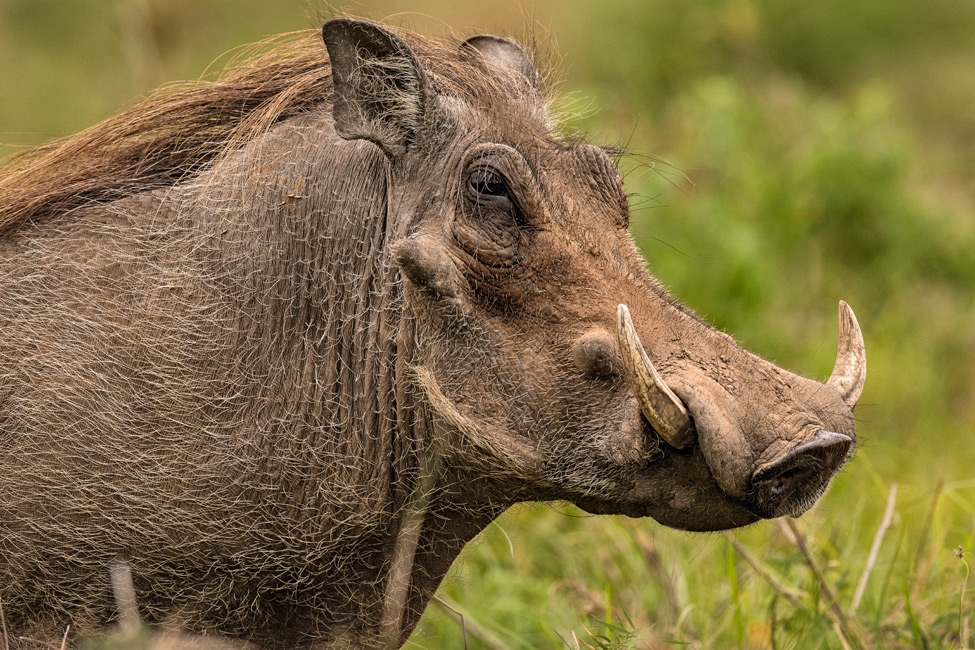
A wild boar in the Masai Mara reserve. "At the crop factor view of 1200mm, the beast becomes a beautiful example of razor-sharp detail against a natural palette of background colors." D500, AF-S NIKKOR 800mm f/5.6E FL ED VR, 1/750 second, f/8, ISO 1100, shutter priority, Matrix metering.
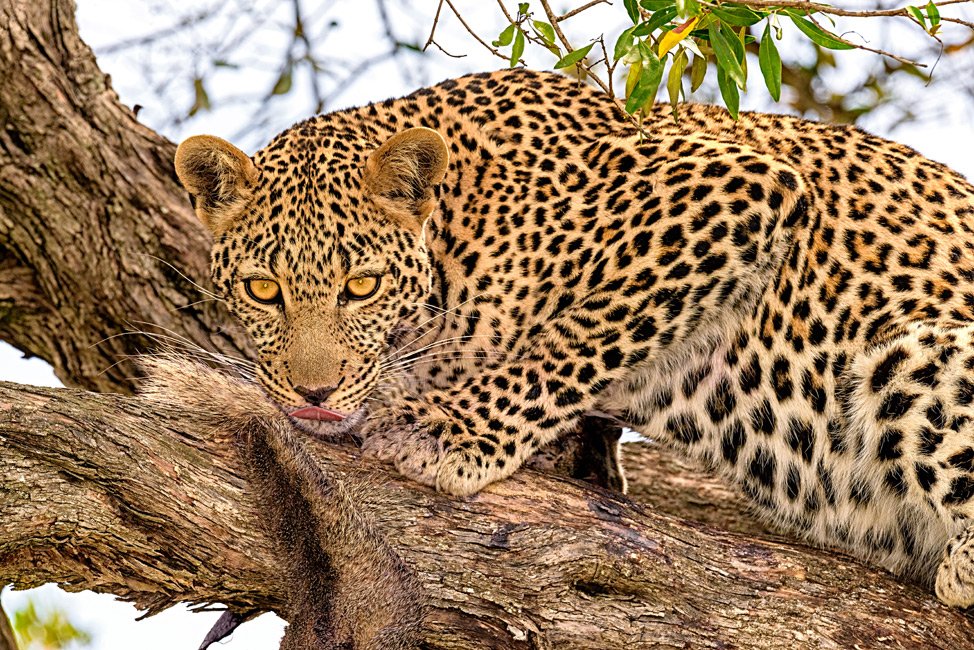
"Think an 800mm super-telephoto is too big to take on safari? Looking into this Masai Mara leopard's eyes, I can think of 800 reasons why you'll want one with you. And remember, on safari you'll be carrying it only from tent to vehicle. It wasn't a big deal to work with that lens each day." D810, AF-S NIKKOR 800mm f/5.6E FL ED VR, 1/750 second, f/11, ISO 800, manual exposure, center-weighted metering, SB-900 Speedlight.
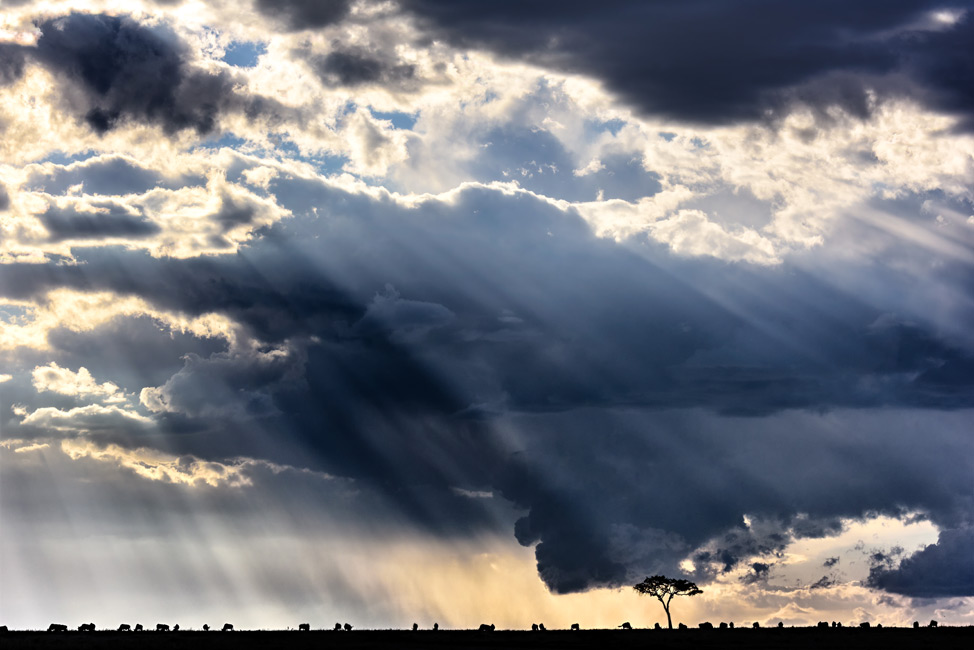
"With wildebeests across the ridgeline, the sky spilling rays on Masai Mara and a natural spotlight highlighting an acacia, you just have to shoot and take it all in." D810, AF-S NIKKOR 80-400mm f/4.5-5.6G ED VR, 1/500 second, f/13, ISO 200, shutter priority, center-weighted metering.
T here's a lot to be said about the benefits of a backup camera.
First, well...it's self-defining, isn't it? If your camera slips from your grip and goes into the river, your first thought—Thank goodness I have insurance—is going to be followed by, Thank goodness I've got a backup.
There's another big advantage, though—one brought up in a conversation we had with photographer, workshop instructor and photo safari leader Mark Alberhasky not long after he returned from Kenya. Mark's idea: definitely carry two Nikon camera bodies, but make one an FX, the other a DX.
"I was able to travel light, but cover all the bases with a combination of a full-frame FX and a crop-factor DX camera," he said of his trip. His D810 was the former, his D500 the latter, and with those two bodies, a minimum of lenses provided maximum potential, as he carried less weight without sacrificing focal length.
Mark passes the mix-and-match advantages on to his safari first-timers. What he tells them—and he does it when they sign up, not when they show up—is that the professional edge is one FX and one DX camera. "That's what opens doors for them," he says.
The choice of DX and FX camera bodies ties directly into lens selection. Here's how it works.
"I know from experience that for the first-timer, a 70-200mm lens is most likely the big telephoto, so the first thing I have to do is get them to realize that to do wildlife justice, they're going to need a longer focal length."
Like an 80-400mm? "That's a pretty decent lens for a safari," he says, but lately he's been thinking longer than that: the 200-500mm, which, on a 1.5X crop factor DX body, provides the equivalent view of a 300-750mm zoom. Now you're really talking extra reach and close-up detail. "Ninety percent of wildlife photos, no matter where you are—Africa or Yellowstone—will be taken between 300mm and 600mm," Mark says.
The Right Stuff
As soon as Mark's clients decide to go on safari, he starts sending them information on what clothes to wear, what luggage to bring and how to pack. Perhaps most important, he sends a whole lot of ideas about equipment.
"I address the smart way to travel," he says. "I don't want them to bring every lens they own, so I do my best to get them thinking that they need to get two camera bodies and expand the repertoire of lenses to cover the need for long and varied focal lengths. The key is, don't duplicate—complement."
For example, Mark likes to have his 16-80mm on the DX D500 body and an 18-200mm or 28-300mm on the FX D810. "When I'm working a long lens and the animal decides to walk up within five feet of the vehicle, that long lens on an FX body won't get the picture for me because the minimum focus won't get detail on the animal's face. In that case I need to be able to instantly pick up the D500 with the 16-80mm on it and keep shooting, as the 16-80mm [is] like a 24-120mm on an FX body."
On the Kenya trip, Mark carried a D5 in addition to his workhorse D810 and D500. His lenses were a 16-80mm, an 80-400mm and an 800mm. At one point he took some images with a borrowed 200-500mm. "It's an incredible lens," he says. "It's sharp, compact and a great value. Everybody I know who's shot it, raves about it."
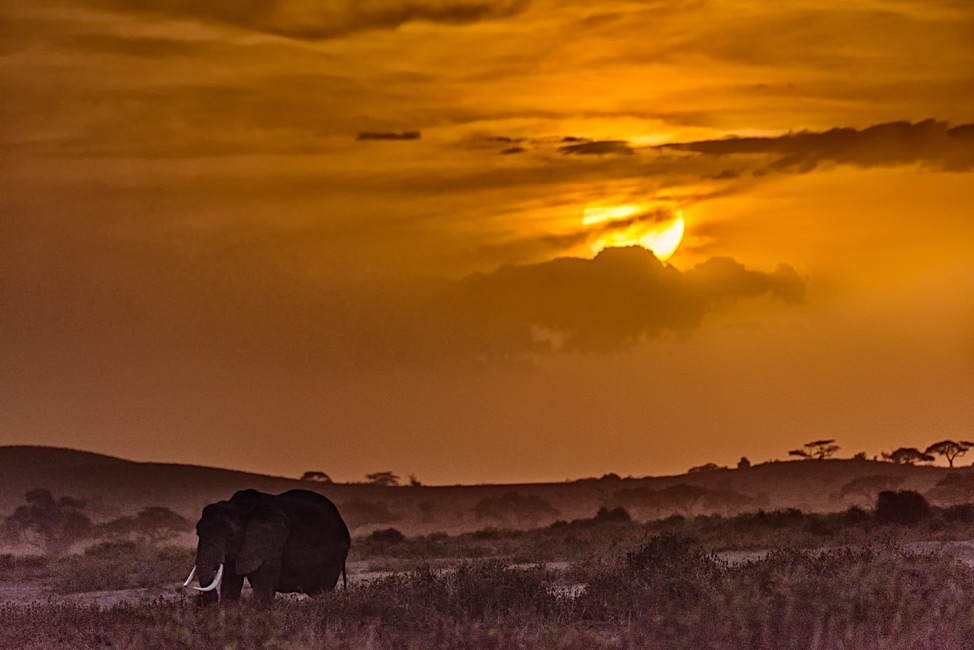
An iconic silhouette in late afternoon light in Amboseli National Park. "The image seems to say, "The sun is about to set on this majestic species. Save it!'" D810, AF-S NIKKOR 80-400mm f/4.5-5.6G ED VR, 1/4000 second, f/8, ISO 800, manual exposure, Matrix metering.
We asked Mark to complement his mix-and-match camera body advice with some of his top tips for successful safari photography. He was happy to oblige.
"Shoot wide, shoot medium, shoot tight."
"Learn to look for small details in the landscape as well as on the animals, then use your DX reach to capitalize on those details."
"Don't become tele obsessed. When first using a tele lens, it's likely you'll take every shot tight on the animal's head—but you should also show the whole body and the animal's environment. Tell the whole story."
"Resist the urge to bring every lens you own. As Jay Maisel says, 'The more equipment you bring, the fewer pictures you'll take.' When the action happens on safari, it happens fast, and you don't want to be switching lenses or thinking about what to use while what you want to shoot is over and done."
"This is important: bungee cord your gear in the vehicle for a secure ride. On my very first safari, I set a lens down on the seat, and when the driver suddenly took off, it went flying."
"Bring a minimum of two beanbags for camera and lens support to cover both sides of the vehicle."
"The most common mistake people make is shooting at too slow a shutter speed and too low an ISO. The animals are almost always moving, and certainly always looking around for what they want to eat or what wants to eat them. Shutter speed should be at least 1/750 to 1/1000 second, the ISO 800 to 1600, and I like apertures of f/8 and f/11. Want to get a bird in flight? That's a minimum 1/2000 second. These are ranges most people don't think about, but should when photographing wildlife anywhere."
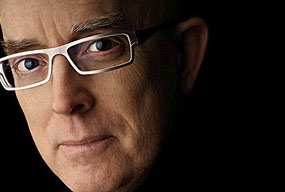
This Article Goes Great With These Products
More from nikon.

Learn photo & video terms

Nikon School
Check out Nikon School.

Check out the Nikon apps.

NEW Mentors online course
Fashion photography with Dixie Dixon, Visual Storytelling with Joe McNally, Wedding photography with Jerry Ghionis and Sports photography with Rod Mar

Nikon Ambassadors
Check out the Nikon Ambassadors.
Stay connected to Nikon.
By clicking Sign Up, you are opting to receive promotional, educational, e-commerce and product registration emails from Nikon Inc. You can update your preferences or unsubscribe any time.
Thanks for signing up!
Review of the Nikon D500 for Wildlife and Bird Photography
A Post By: Shreyas Yadav

Roller with Nikon D500 and Nikon 200-500 f/5.6
Fast action is at the heart of Wildlife photography . Wildlife action is fast and unpredictable. Most of the wildlife, including predators, are active during early dawn and late dusk. During the edge of the day, light conditions are low. Having a range of focal lengths is essential to photograph distant wildlife shots. The weather conditions are harsh in the wild. Moreover, wildlife photographers try to find a camera which is capable of capturing stunning images in every possible situation in the wild.
Nikon crafted a flagship DX-format DSLR camera – the Nikon D500 , with excellent high ISO performance, a faster frame rate, and a fast and accurate focus – even in low light.
- What it is?

Nikon D500 with the Nikon 80-200 f/2.8 lens mounted on Gitzo Tripod
The Nikon D500 camera body weighs around 870g (30 oz) including battery and XD card. It is a crop sensor (DX format) DSLR with a 20.9 MP CMOS sensor. The ISO range is from ISO 100 to ISO 51200. This ISO range is useful in getting better image quality even in low light. In addition to high ISO performance, frame rate and autofocus performance of the Nikon D500 is excellent. Frames per second for Nikon D500 is whooping 10 FPS. The autofocus is fast and accurate in low light as well. Nikon D500 is fully capable of focussing up to f/8 with center focusing points. These key features make the Nikon D500 excellent for Wildlife and Bird photography.
This article is a field-review of Nikon D500 from the perspective of Wildlife Photographer. This review will help you in understanding how the Nikon D500 performs in the field.
Note: All the wildlife and bird images are photographed in the natural forest with uncontrolled light conditions and within their natural habitat.
Images are captured with the Nikon D500 and the Nikon 200-500 f/5.6 lens with a bean bag. Images are captured either from a safari jeep or from a safari boat.
- Specifications
- Sensor and processor – DX format (23.5 mm x 15.7 mm) CMOS sensor with EXPEED 5 processor
- ISO – ISO 100 to ISO 51200 (ISO Expandable from range ISO 50 to ISO 1640000)
- AF Modes – Single Servo (AF-S), Continuous Servo (AF-C), Manual and Full-time Servo in Live View
- AF Area Modes – Single Point AF, Group Area AD, 3D Tracking, Dynamic-area AF with 25, 72 and 153 points, Auto Area AF
- Power – EN-EL 15 Lithium Ion Battery with MH-25a charger
- Storage cards – SD, SDHC, SDXC, and XQD cards. One slot for SD card and another slot for XQD card
- Dimensions and weight – Approximate weight of the body including Battery and card is 870 g (30 oz) and dimensions are (Width x Height X Depth) 5.8 in (147 mm) x 4.6 in (115 mm) x 3.2 in (81 mm)
- Frame rate (FPS: Frames per second) – 10 FPS in Continuous High Mode and for Continuous Low mode FPS Selectable from 2 to 9 FPS
- Shutter release modes – Single, Continuous Low (2-9 FPS) and Continuous High (10 FPS), Mirror Up, Self Timer and Quiet release
- Shutter speed range – Slowest shutter speed is 30 s, and Fastest shutter speed is 1/8000 s
- Metering modes – Spot metering, Center-weighted metering, and Matrix metering
- Exposure mode – Manual (M), Aperture Priority (A), Shutter Priority (S) and Programmed Auto (P)
- White Balance – Auto, Cloudy, Direct Sunlight, Flash, Fluorescent, Color Temperature (2500 k to 10000 k)
- Flash – No Built-in Flash and External Flash is required
- Image format – JPEG (Basic, Normal, Fine), NEF / RAW (12-bit or 14-bit with an option of Lose less compressed, Compressed and Uncompressed)
- Lens compatibility – Full compatibility with Nikon AF lenses with G, E, D type and DX-format lenses. Partial compatibility with PC lenses, AI-P, and Non-CPU lenses
- Controls and ergonomics

AF-ON is useful in back button autofocussing. The focus area selection button is next to the AF-ON button. The Nikon D500 has a touch screen, and it can tilt up to a certain angle.

Buttons for selection of White Balance, Exposure Mode, Metering and Image Quality.

Shutter release mode dial.

Buttons for Exposure compensation, ISO selection, and movie recording.

Focus mode selection button.
Controls on the camera feel perfect for wildlife photography.
Here is why:
- Exposure selection mode – This button helps to select the exposure modes – Manual (M), Aperture Priority(A), Shutter Priority(S) and Programmed Auto (P)
- Frame rate setting – This dial helps to set the Frame rate as Single ( S), Continuous Low ( CL), Continuous High ( CH ), Timer and Mirror lockup
- ISO and exposure compensation setting – the ISO button allows you to change the ISO quickly
- Focus point selection dial – The Focus point selection dial helps select focus point
- Focus mode and Focus area mode selection – This button, along with Primary and secondary dials ( Dials used to change the shutter speed and Aperture), is used to select focus modes as Single, Continuous and Auto. The same button is used to choose focus areas such as Single, 3D, Dynamic with 25,72 and 153 focal points, Group area and Auto-area
- Metering selection button – You can select Spot, Center of Matrix metering from this button quickly. In Wildlife photography switching between Matrix and Spot metering is often required depending on the light conditions
- AF- ON button – This is one of the most useful buttons on the Nikon D500 for wildlife photography. If the bird is standing on a tree branch or takes quick flight , the AF-ON button helps to capture the image with accurate focus.
- Build quality and weather sealing
- The Nikon D500 is mostly made up of magnesium alloy, carbon fiber, and plastic
- The weight and size of the Nikon D500 are suitable for all day shooting and even hand-holding. The size of the D500 is perfect while you travel in the wilderness and it is perfectly sized while hiking and traveling in the safari vehicle.
- Body toughness of the Nikon D500 is decent but not great as that of Nikon D5 . I find the durability of earlier versions, such as Nikon D200, D300 or D700 was better than D500. However, the build quality of Nikon D500 feels slightly better than the Nikon D7100 or the Nikon D7200 but up to the standard of flagship DX body.
- Protection against dust and water splash is decent enough
- I have used Nikon D500 in moderately dusty environments and medium drizzle. The camera performs fine. In fact, I clean the camera after a photoshoot in the rain or heavy dust and I recommend you do so too. This type of weather sealing may be sufficient for mild dust and water splashes, but it doesn’t look good enough in extreme weather.
- Ergonomics and handling
- Ergonomically, the Nikon D500 feels just right. Important command dials for wildlife and bird photography are located on the camera body itself. This helps you to change the settings quickly.
- Hand-holding, the Nikon D500, feels better. One caveat is the video recording button is located a bit oddly. Despite using it multiple times, I still get confused in locating the video recording button. Apart from the video recording button, you will find the buttons and dials are at the right place with the correct size.
- Camera performance from the perspective of Nature and Wildlife photographer
- Autofocus performance

Osprey in flight. Focus performance of the Nikon D500 for Birds in flight is excellent. Exif : 1/800s , f/8 and ISO 450
Bird action happens fast and can be erratic. Wildlife movement is also fast as it occurs at dawn or dusk. The ability of the camera to focus fast and accurate is a must. With the Multi-Cam 20K Autofocus Sensor module, Nikon D500’s autofocus capabilities are excellent. The Nikon D500 focuses accurately (provided you choose the appropriate focus mode and focus area mode).
I use back button autofocus for focusing. There is a dedicated button for back button autofocus, which is AF-ON.

Hare in the clutter. The Nikon D500 precisely acquires focus on the main object even through the forest clutter.
The Nikon D500 focusses extremely well in following conditions:
- Cloudy and rainy weather
- Distant objects
- In the forest clutter and forest canopy
- Dusty and snowy weather
- Birds in flight and animals in action
In terms of autofocus performance, the Nikon D500 is an absolute winner.

Deer crossing the safari track. The camera’s focus performance for distant objects is excellent. This deer was crossing the Safari road. The distance between the deer and our vehicle was around 100 meters
- Image quality – Colors, details and dynamic range

Colors of the peacock. Color rendition and image quality of the Nikon D500 is great. Exif: 1/100s, f/5.6 and ISO 720
Colors, tonal range, and dynamic range of the Nikon D500 images is excellent. Metering of the Nikon D500 is fantastic. It evaluates and produces correct image exposure.

Stare of an eagle. The Nikon D500 captures the details perfectly. Exif: 1/400s, f/5.6 an ISO 500
For most of my wildlife images, I use Matrix metering . For some tricky light situations, such as harsh lights or shadows, and if the animal is dark or bright, I switch to Spot metering mode. Matrix metering will give you excellent light exposure.

Jungle fowl calling. Feather details are excellent. Exif: 1/250s, f/5.6 and ISO 450

The elephant in its kingdom. Colors and details of the elephant are accurate. Exif: 1/1000s, f/5.6 and ISO 2200
The dynamic range of the Nikon D500 is improved as compared to earlier versions of the DX format Nikon cameras. If the light is sufficient, I set the exposure compensation to +0.3 or +0.7. Exposure compensation shifts the histogram towards the right. It helps in bringing out the details and enhancing the colors in an image.

The Dynamic Range of the Nikon D500 is wide. The camera was able to capture the eyes and feathers in the shadow. Equally, the Nikon D500 captured the highlighted crest on the head perfectly.
- High ISO and low light performance
Image quality and ISO performance in low light are much improved in the Nikon D500. The camera ISO has a range from ISO 100 to ISO 51200. In controlled light conditions or lab test, the Nikon D500 Images may look less noisy. However, when you are shooting with the Nikon D500 in the real jungle and natural light conditions, you have to be realistic when you select your ISO.

Peacock at ISO 1600
I use a maximum ISO up to 6400 in most cases, and for some rare wildlife moments, I go up to ISO 12800. In the forest, especially during the early morning or late evening, an ISO of up to 6400 helps. With ISO 6400, I can get a sharp image with excellent dynamic range. The colors are also good. These images are perfectly usable for big prints and web-sized images.

Bond of Nature. Family portrait at ISO 4000
Whereas, if you go ridiculously high on ISO such as ISO 51200, you will still get an image, but you will have to apply Noise reduction in post-processing. Also, the image loses the fine details. If you are going to print the image, select the reasonable high ISO at the available light conditions.
- Bottom line
The Nikon D500 has improved high ISO and low light performance. Up to maximum ISO 6400, images are great. The sharpness and colors are fantastic and noise levels are low and manageable in post-processing.

Sambar deer at ISO 6400. It was almost dark in the forest. Luminance noise is visible in the image.

Mongoose at ISO 6400. It was almost dark in the forest.
- White balance

Fish eagle on the perch. Auto White balance for the Nikon D500 produces color temperatures and tint accurately.
The auto white balance of the Nikon D500 is accurate. The camera produces white balance without any shift in color or tint. All the color temperatures look right.
Other than Auto White balance, there are different white balances available such as Daylight and Shade. All produce good results.
For wildlife and bird photography, I recommend you choose Auto White Balance. It will help to reproduce the correct white balance for your images. If you want to add creative effects, you can always tune the raw image in post-processing.
- Bonus: My D500 camera settings for wildlife and bird photography
- Image Quality: RAW
- NEF (RAW) Recording: NEF RAW Compression: Loose-less compressed and Bit Depth: 14-Bit Depth
- Color space: Adobe RGB
- Picture Control: Standard (SD)
- ISO: Auto ISO with Maximum ISO as 6400 (It will depend on the lighting conditions, but I find 6400 is the right balance for image quality and low noise)
- Autofocus mode: AF-C (Continuous)
- Autofocus Area mode: Dynamic (25 points) or Group area focus
- Exposure mode: Manual (Shutter speed and Aperture will be set based on the available light in the environment). You can also use Aperture priority as an Exposure Mode.
- White Balance: Auto
- Metering: Matrix
- For autofocus, use Back button autofocus: AF-ON
- Shutter release mode: Continuous High CH (10 FPS) or Continuous Low CL (6 FPS)
- Conclusion and recommendations
- 10 FPS (Frames Per Second)
- Fast and accurate focus even in low light
- Good High ISO Performance
- Superb image quality and dynamic range
- Excellent ergonomics
- Perfect location of camera buttons and dials
- Autofocus with central autofocus points up to Aperture of f/8
- No Built-in flash and GPS
- Location of the video recording button
- Above average Build quality and weather sealing (Not the best in class)
The DX sensor, superior autofocus performance, high ISO performance, best in class frames per second (10 FPS), and travel-friendly size makes the Nikon D500 perfect for wildlife and bird photography.
You will love using Nikon D500 in the wild.
What do you think about the Nikon D500 camera? Please do let us know in the comments below!

Table of contents
Wildlife photography.
- Nature and Wildlife Photography Tips for Beginners
- 6 Tips to Capture Wildlife Photography with Impact
- 5 Ways to Challenge Yourself as a Wildlife Photographer
- How to Take Better Wildlife Photos: Be a Naturalist First
- 5 Different Approaches to Photographing Wildlife
- 5 Things I Wish I Knew When I First Started Wildlife Photography
- How to Find Animals for Wildlife Photography Beginners
- Guide to Attracting Critters to Your Garden for Backyard Wildlife Photography
- How to Be Respectful and Safe Photographing Wildlife
- Wildlife Photography – Consider Your Subject First
- How to Expose Correctly for High Contrast Wildlife
- Making Sharper Wildlife Photographs – [Part 1 of 2]
- Why Semi-automatic Mode is the Best Choice for Wildlife Photography
- The Importance of 'Enough' Depth of Field in Wildlife Photography
- Why Manual Exposure is Better for Winter Wildlife Photography
- Manipulating Natural Light in Wildlife Photography
- How to do More Creative Wildlife Photography by using Rim Lighting
- Turn your DSLR Camera into a Wildlife Camera Trap
- 6 Tips for Getting Sharper Wildlife Photos With a Super Telephoto Lens
- How to Use a Wide-angle Lens with Wildlife for a New Perspective
- Wildlife in Context – The Short Lens Approach to Wildlife Photography
- Field Test: Could the Nikon 200-500mm f/5.6 be the Most Versatile Wildlife Lens?
- Full Frame or APS-C for Wildlife Photography – Which is Best?
- 5 Top Value Lenses for Getting Started in Wildlife Photography
- Some of the Pros of Using Micro Four-Thirds Cameras for Wildlife Photography
- Review: Sigma 60-600mm f/4.5 – 6.3 DG OS HSM for Wildlife Photography
- How to Choose the Best Lens for Wildlife Photography
- How to Choose the Right Camera Bag for Outdoor and Wildlife Photography
- Writer's Favorite Wildlife Lens – Tamron 150-600mm
- 5 Tips for Photographing Wildlife in Low Light Conditions
- 7 Tips for Better Marine Wildlife Photography
- 6 Tips for Capturing Action in Your Wildlife Photos
- 6 Tips for Capturing Character and Personality in Wildlife Photography
- Remote Wildlife Photography From My Basement
- Tips for Black and White Wildlife Photography
- 3 Lightroom Tools to Enhance Your Nature and Wildlife Photography
- A Walk on the Wild Side: A Collection of Wildlife Photography
- Wildlife Photography Stories from the Field [Book Review]

Read more from our Cameras & Equipment category
is an engineer, wildlife photographer, and nature photographer from India. He is also a writer and lifelong adventure explorer. Through his writings, he teaches about digital post-processing and nature photography. He shares field techniques about nature photography, post-processing, and wildlife photo stories on his website.

- Guaranteed for 2 full months
- Pay by PayPal or Credit Card
- Instant Digital Download

- All our best articles for the week
- Fun photographic challenges
- Special offers and discounts


Nikon D500 review: The wildlife photography featherweight champion
For wildlife photographers, seeing a new, true, Pro DX body in the Nikon line-up has been a longtime coming. Seven years after the D300s was first announced, the D500 is here. And, it is exceptional. That’s a good thing too as more than that, it is possibly the most anticipated Nikon DSLR of all time.
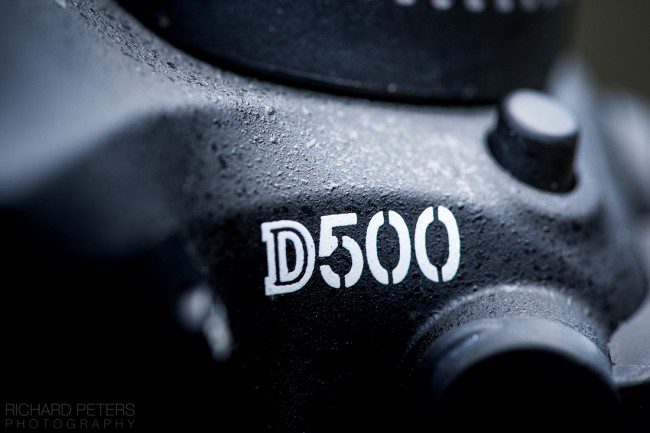
My Nikon D500 review
Before we skip to the present, there’s one other historical point of reference to mention. The release of the D500 also echoes something that happened when the D3 and D700 were released. Sure it’s not an FX camera but it shares some of the key new features of it’s flagship bigger brother, the D5. Because of that, I was in two minds about the approach to writing this. On the one hand, the D500 is a sublime camera in it’s own right but, at the same time, with those comparisons to the D5 inevitable, it almost feels impossible to not cross reference the bodies – even if the target markets for the two aren’t entirely the same.
[clickToTweet tweet=”The Nikon D500 is a dream camera for wildlife photographers!” quote=”The Nikon D500 is a dream camera for wildlife photographers!”]
With that in mind, for added reference please read my recent D5 review , which covers additional thoughts on some of the shared features. The D500 also features in the cameras that shaped my photography . A look at my favourite models that I’ve shot with and used over the years, from the D100 onwards.
Update: September 2017 I have now replaced the D500 with a D850. You can read my full review of the D850 here . Otherwise, continue on to find out why I still rate the D500 as an exceptionally good DSLR.
Back to the D500 review… I have broken this review (or, opinion) down into several main sections. Yes there are a lot of features on the D500, and other cameras, but I don’t use them. I tend to keep it simple and stick with the fundamental important areas. The things that I rely on to capture the images I’m after.
The Body The Focus The Sensor and Image Quality The Speed The Conclusion
Given it packs a DX sensor, the D500 form factor is surprisingly and reassuringly large, being a little bigger than the FX D750 and a little smaller than the D810. Weight wise it sits between the two as well but that initial body size gives a clue as to the power that hides beneath, reminding us this is the new flagship DX camera. A deep grip makes it easy to hold and the ergonomics are typically Nikon-esque, which is a very good thing. It doesn’t matter which camera you are coming from in the Nikon line-up, everything feels similar. Being a new generation camera and twinned with the D5, it shares some physical characteristics such as a round eyepiece for the viewfinder, backlit buttons in the dark (both a welcome first for a DX body, although way back in the day, the D2x had a round eyepiece) and layout changes including moving the ISO button to share space next to the shutter release and, my favourite, a new function button, Fn2, found at the bottom left of the rear which can be set to rate images. I can’t stress how much I love the ability to quickly star rate images in camera. More of this in future bodies please!
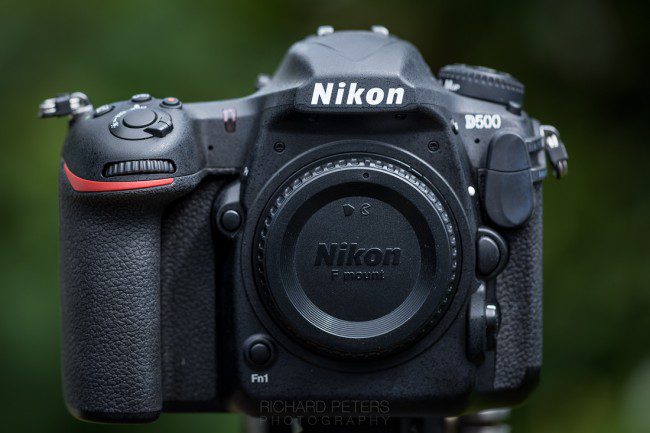
Missing from the new DX camera is a pop-up flash, which provides a further nod to the Pro heritage and is a first for a crop sensor, small bodied, Nikon. To counter this the D500 supports radio controlled flash technology that is found with the new SB-5000 but, despite the lack of pop-up it will still work with Nikon CLS if you have a supported flash, which will act as a controller when inserted in the hot-shoe (although that means you need at least two flash guns). Personally, although I use flash when working with camera traps I haven’t used the pop-up on my D810 in a very long time as I use wireless flash triggers. From a personal perspective, I prefer having no pop-up because I consider it a weak point of the body, in the event of accidental dropping or knocks. Therefore although I welcome the removal of the pop-up flash on the D500, I can appreciate why, depending on your setup, it could throw you a bit of a curve ball.
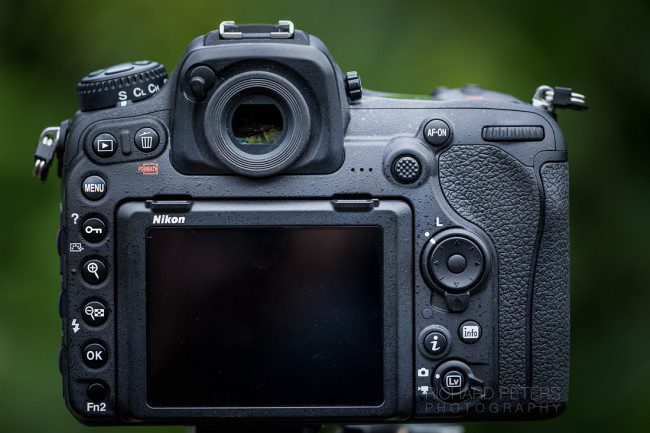
The D500 shares the same high resolution touch sensitive screen as it’s bigger brother but offers it with tilting functionality. I really like this because it makes the camera far easier to frame up when used in a trap camera scenario that requires the camera to either be low on the ground or in an otherwise awkward position. In that type of application, I would favour a tilting screen over a fixed one if given the choice. There is an internal felt grommet to keep out dust where the cable for the screen enters the body, although this does not feature the same weather sealing as the rest of the controls. With this in mind, I would be inclined to keep the screen retracted if it were raining.
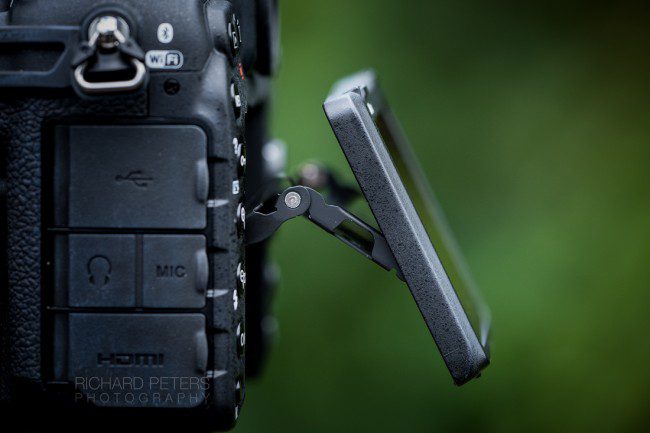
Overall, working with the D500 is a very nice experience although to really get the most out of pairing it with a large telephoto lens, you need to have the additional MB-D17 grip to add more weight and improve the handling. Given there will be a huge wildlife photography user base with this camera I’d say the grip is essential with any significantly sized or weighted telephoto (200-500, 200-400, 300 f2.8, 400, 500, 600). Without it the balance is off on those larger lenses and with my Wimberley MKII I found myself needing to slide the lens as far back as it would go in the cradle to balance properly. Handholding proved to be a little tricky with my 400mm and whilst it was possible, the balance just wan’t there meaning there was more requirement to rely on VR to keep things steady. This isn’t a specific problem of the D500 but more simply the curse of all smaller bodies. With my two D810’s I have one with a grip (the one that the 400mm lives on) and one without to keep size and weight down. Grips can be a little cumbersome, sometimes bulking out the camera significantly, but the advantages outweigh the disadvantages if you shoot with any of those larger, heavier, lenses. The D500 being no exception.
The viewfinder on DX cameras have always felt a little claustrophobic in the past but a little less so with the D500, which is welcome. Smaller viewfinder space means the ISO value is not displayed by default when using Auto ISO, instead, requiring a custom setting to display the ISO value in place of the shots remaining. I can’t remember the last time I looked at shots remaining, even less so on a camera with a buffer of 200 RAW files, so would recommend setting this in your camera too (custom settings menu – option d3, set to ON), especially if you use Auto ISO frequently.
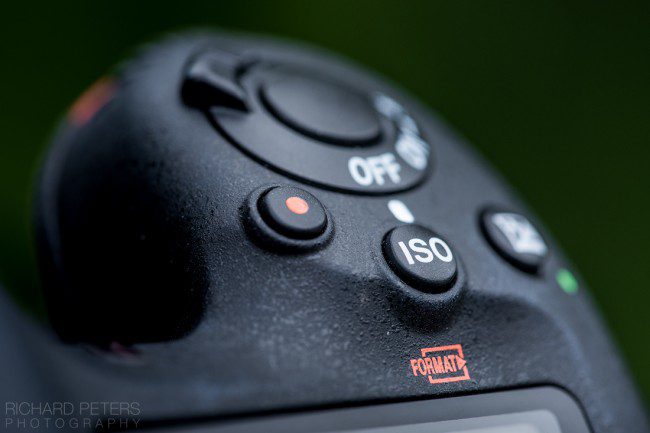
Just like the D810 and several other bodies, the D500 shares the same EN-EL15 power source. Aside from the compatibility issue with the older Li-ion01 generations of this battery (which Nikon will replace for free, should you have any, to the latest Li-ion20 version), you get around 1200 shots per charge. However in conjunction with the grip, you can use two of these to increase your time between charges. During our three days on Skomer Island, I didn’t take a charger so as not to put an extra drain on the solar power at the accommodation and, on the second evening, the first battery ran out of juice. By the time we left the island I’d used half the second battery. Of course power drain will vary on how much you shoot, use VR etc but I found the D500 to last an adequate time on a single charge – just don’t forget to turn off wifi and bluetooth if you don’t need them. If you do have the grip you can always use the D5 batteries too, if you really want a high capacity power source and don’t mind buying a new charger.
Having covered my initial thoughts on Nikon’s new 155 point Multi-CAM 20K focus system in my D5 review, I’ll not recover too much ground here. Photographing puffins in flight on Skomer Island, which is always a tricky proposition unless the wind is slowing them down, was far more enjoyable with this new system. In that particular scenario I found setting it up to use Group AF, with Lock-On delay set to 3 and subject motion to erratic, it was clearly evident I was able to maintain focus acquisition far better than I have done so in the past.
Where the two cameras differ is of course in their autofocus point coverage. Whilst the bigger brother sees a 30% increase in autofocus coverage across the viewfinder that means the D500, with its DX cropped sensor, gets edge to edge coverage and leaves only a thin empty strip top and bottom. The result is an unprecedented ability to position your subject virtually anywhere in the frame and still be able to put a focus point over them.
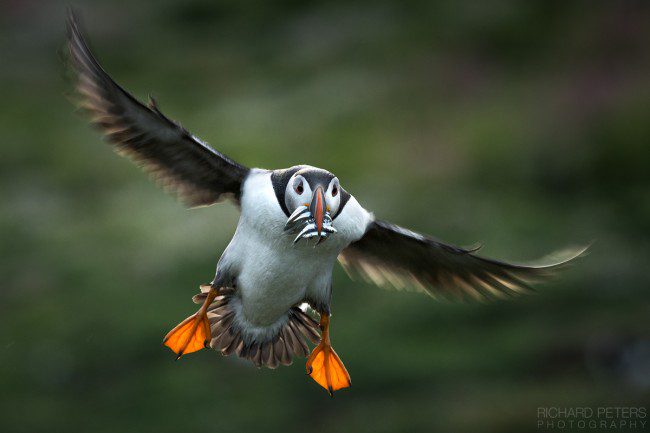
400mm, 1/200, f8, ISO 360
For as long as I can remember, I, along with many others I’m sure, have been plagued with situations in which I am no longer able to frame a shot how I want because I have to recompose the image to allow for focus placement. That’s ok with static subjects but tricky with ones in motion. Having this type of viewfinder coverage is incredible and the freedom of composition it provides is liberating. I’d almost go so far as to say it’s worth buying the D500 just for this!
[clickToTweet tweet=”The D500 autofocus point coverage makes it almost worth buying alone!” quote=”The D500 autofocus point coverage makes it almost worth buying alone!”]
The drawback to the focus point coverage is that the more sensitive cross type sensors are at the extreme edges of the frame, giving you the less sensitive AF points on the rule of thirds. Generally this isn’t an issue but they’re the first ones to be compromised as light levels drop or you need to add a teleconverter to your lens. That’s a small price to pay though as there is no denying after having almost full image autofocus point coverage, picking up any other camera without it feels very compromised and restrictive!
THE SENSOR AND IMAGE QUALITY
Packing a new 20.9mp sensor, the D500 has a native ISO range of 100 to 51,200. It did come as a surprise not to see more resolution but compared to the D7200, which is currently the highest resolution DX sensor on offer with 24mp, but you’re actually only losing around 500 pixels on the longest edge of the image. It has been suggested the D500 doesn’t provide any real big gains in image quality over the, already very good, D7200 at higher ISO levels but looking at the very few D7200 files I have, I’d say the D500 certainly has a more appealing grain structure. Without shooting the same subject at the same time, with the same lens and lighting, it’s not a robust enough comparison for me to say with any certainty how much better I believe the D500 to be, I just know I definitely prefer the overall look of the files.
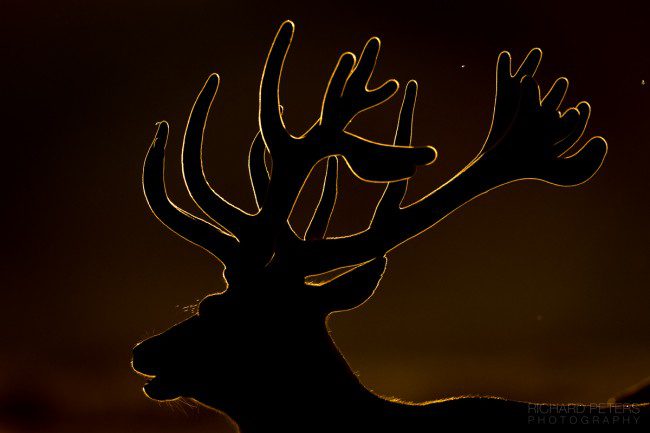
400mm, 1/5000, f2.8, ISO 140
Good news for those who are concerned about dynamic range. I found the D500 to cope surprisingly well at recovering under exposed images at lower ISO. I didn’t spend too much time going out of my way to trick the camera into producing bad results because a problem is only a problem, to me, if it stops me shooting the way I want. However, on several images I intentionally underexposed by 3 or 4 stops, in good light, and found the recovery to be very acceptable for the most part and more so than the D5.
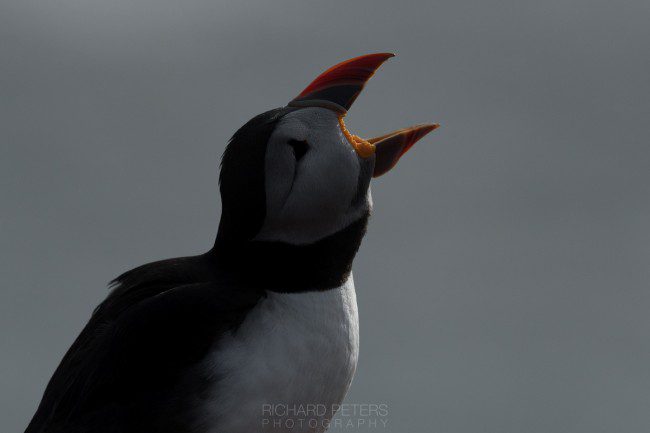
Intentionally underexposed by around 3.5 stops.
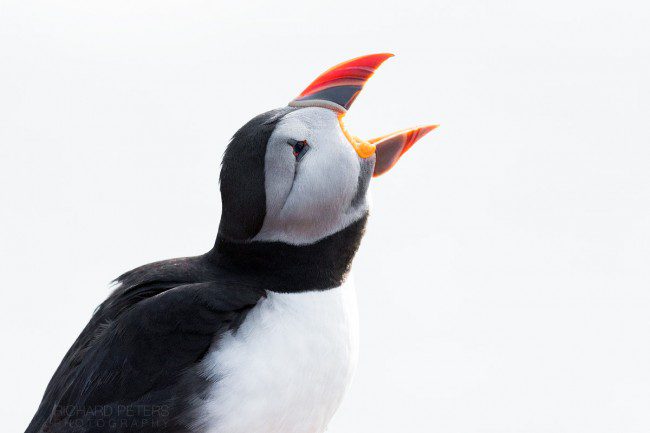
Same image recovered in Lightroom. 1/5000, f5.6, ISO 500
As luck (or lack thereof) would have it, I had very little opportunity to genuinely shoot in low light but I did pay another visit to the ProHides little owl hide one evening and managed a few frames around the ISO 9000 to 16,000 range. This led me to believe ISO 16,000 was pushing the sensor a little more than I feel comfortable with, although the grain structure is definitely nice and more in keeping with FX files. I’ve not had chance yet to print any images yet, which is the most telling way to assess a sensors image quality, but based on what I’ve looked at on the computer screen I would say ISO 12,800 would be the very top end of my comfort zone. Depending on the final output however, you can definitely shoot higher if an opportunity to capture something you might not see again presents itself.
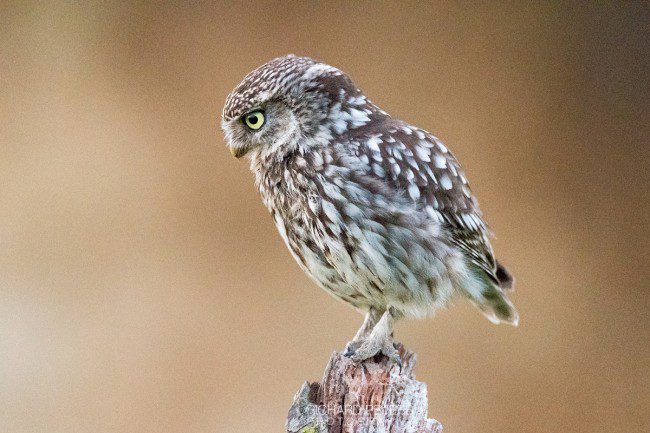
400mm, 1/400, f2.8, ISO 16000
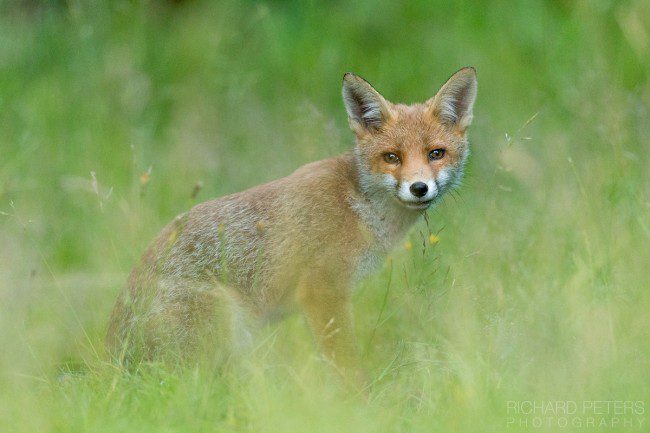
Garden Fox. 400mm, 1/400, f2.8, ISO 2500
Overall I was suitably impressed with the quality in the low to mid ISO range. Despite the top end ISO 51,200 being only a stop less than the D5 on paper, I wouldn’t consider it an out and out low light machine and in practice it’s two or maybe even three stops behind the D5 (depending on light levels) but the files are very nice in typical light conditions, with a little more room for error if you don’t nail the exposure in camera.
Again much like it’s bigger full frame brother, the D500 is fast at everything it does. Its 10fps and huge buffer make it perfectly suited to high speed action and, although the shutter isn’t quiet, it’s not imposingly loud either. In another first there is an XQD card slot outside of a flagship camera alongside an SD card slot, which is UHS-II enabled. This allows for lightening fast buffer clearing whereby it doesn’t matter how many frames you fire off, the writing to card LED indicator goes off almost as soon as you lift your finger from the shutter release. In terms of wildlife, there will be very few times the D500 stops you shooting whilst you wait for images clear to the card, if ever.
The inclusion of two memory card slots is a tricky one. Unlike the D5, which can have either dual XQD or dual Compact Flash, the D500 taking two types of memory is mildly problematic in much the same way it was with the D4 and D4s. Having two differing card slots is nothing new but when one is XQD, it means a possible requirement for new cards to be purchased by those who like two in the camera at once. In the short term it’s an inconvenience but as XQD becomes more popular and mainstream I suspect we’ll start to see it replace more and more card slots in future with bodies across the range.
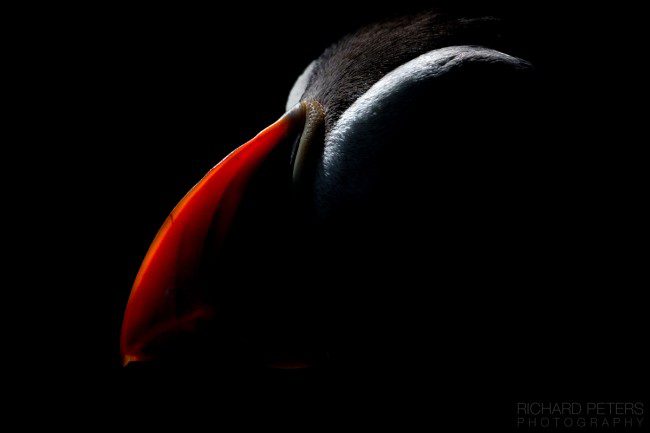
400mm + TC-20EIII (800mm), 1/5000, f8, ISO 560
Theoretically, having two differing types of card in the same camera will impact the time it takes the buffer to clear and therefore the amount of frames you can take in a burst. If you have your D500 setup so that it writes to two cards at once, it’s only ever going to be as fast as the slowest card. At the time of writing, the fastest XQD card is 50% faster than the fastest UHS-II SD card. I never shoot to two cards at once, instead using the second as an overflow. In this situation I would always set the camera to use the fastest card first but if you do shoot RAW and jpeg simultaneously or use slot 2 as a backup, just keep your reduced buffer clearing speed in mind.
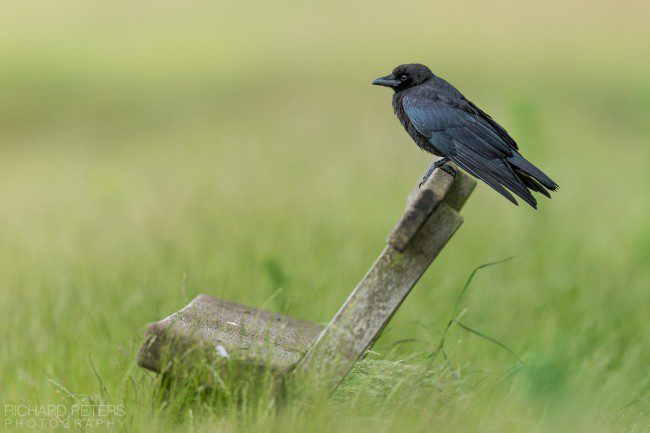
400mm, 1/400, f2.8, ISO 200
Lets be clear though, the D500 is ridiculously fast. It is built for speed. And built well. The shutter release is nice and responsive whilst still allowing you to only fire one or two frames if required, even if you’re in Continuous High mode and the viewfinder black out time is also quick, although it is noticeably slower than the D5. It’s certainly no slouch but it does make observing the action through the viewfinder, and following your subject, slightly less engaging when shooting at 10fps but if you’re coming from a slower camera, which is most likely the case, the D500 is going to feel every bit like the pocket rocket that it is.
THE CONCLUSION
The new top of the range DX Nikon was most definitely worth the wait. The sensor isn’t quite the vast leap forward it may sound on paper but it is very capable, within it’s limits, and you’re getting so much more besides. Should you buy it? Yes. Quickly. Rush out and buy the D500. All of you. Stop reading and do it now. Off course I’m (half) joking. As I’ve said before there are so many factors that feed into your decision. Cameras are simply tools so what you shoot, how you shoot and what you currently shoot with all makes a difference. As I did with the D5, I will break it down as follows:
Consider it if: You regularly shoot fast action subjects You want an autofocus system that is second to none You want almost full frame focus point coverage You shoot with telephotos more than wide angles
Don’t consider it if: You often need very high ISO or shoot in exceptionally low light You need ultra high resolution You regularly shoot in very harsh conditions
Then of course you need to factor in whether you currently shoot FX or DX. For current DX shooters, it’s easier because this is the best camera in the range. For FX shooters looking for a backup (or even new main body) there’s more to consider.
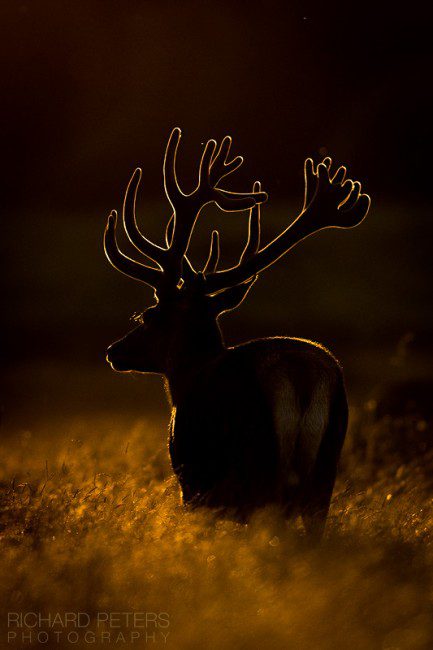
1/5000, f2.8, ISO 360
If you own a D800/D800E or D810 it’s more a question of trade-offs. 36mp already gives you almost the same image size as D500 once cropped (and with one of the best low light sensors available) so it becomes a question of speed. If you need speed more than resolution or shoot with a 24mp FX camera such as the D750 or D610 then the D500 again becomes a very tempting proposition.
How does it compare to the D5? Well, yes, they share some very similar attributes but it’s not quite on a par with its bigger brother with regards to build, ergonomics, controls and low light performance. All of which are crucial if your camera is a real work horse used in harsh conditions for specific tasks.
One thing is clear though, no matter which way you look at it. In its own right having a relatively high resolution crop sensor, fast frame rate, insanely quick clearing large buffer and world class autofocus makes it the undisputed featherweight DSLR champion. It’s just as at home with a 400 f2.8 on the end as it is a 300 PF , making it a powerful and flexible choice for professionals and amateurs alike.
Or to put it another way, the D500 is currently the best general purpose wildlife photography camera on the market.

Recent Posts
About the author.
Richard Peters is a Surrey based professional wildlife photographer, Nikon Ambassador, and one of the few British photographers to receive the accolade of European Wildlife Photographer of the Year. He is known for a style that often favours dramatic use of light, runs wildlife photography workshops and, from camera clubs to big industry events, holds talks about his work.
If you'd like to know about Richard's latest blogs, workshops and more, all designed to help you improve your photography, join the newsletter today.
[email protected] FOLLOW ON INSTAGRAM
HOME WORKSHOPS PRINTS BOOKS AWARDS GALLERY BLOG A BOUT
Nikon Z8 & Z9 guide Wildlife AT Home
SAFARIS & WORKSHOPS
ONE-to-ones LIghtroom classic editing British wildlife Maasai mara Zambia south luangwa AMBOSELI Elephants Namibia Finlands wild bears
Finland summer predator s
Finnish autumn predators Skomer Island Puffins

All content © 2023 Richard Peters Photography
Pocket-lint
Nikon d500 review: the best aps-c dslr ever made.
It's been a long time since Nikon launched the D300, a camera that arrived at roughly the same time as the very first iPhone. Yep, that long ago. That camera's successor, the D300S, hit the market last decade too. But now the long wait for a replacement model is over: the Nikon D500, the spiritual D300 successor, is here - and it's been making waves.
Our quick take
The Nikon D500 is a DSLR with little compare. It steps up beyond the Canon EOS 7D Mark II (assuming that isn’t replaced at Photokina 2016), while the range of Nikon DX optics will see it as the more practical solution compared to the Pentax K-1 for many - even if the Pentax has some standout features like the variable LCD screen.
In short, therefore, the Nikon D500 is certainly a contender for the best APS-C camera made to date. There are only some small gaps in its capabilities - such as unnecessary extended "Hi" ISO settings, slight hunting in the live view autofocus - but otherwise its awesome autofocus system and all-round capabilities are second to none.
Nikon D500 - 5.0 / 5
One of the most advanced, feature-rich APS-C bodies we've tested. It comes at a nice price point and offers a compact shape, too.
Nikon has gone all out for the D500, which is a lot like the top-end D5 pro DSLR in many respects. It does, of course, swap the latter camera's full-frame sensor for a smaller APS-C one and ditches the massive £5,200 body-only price for an altogether more accessible £1,799, too.
With a 153-point autofocus system, 10fps burst mode, 21-megapixel sensor with ultra-high sensitivity (to ISO 51200, which expands into six figures with Hi1-5 extended options), there's not a lot missing.
Is, therefore, the Nikon D500 the best APS-C DSLR camera made to date? We've been shooting in Chicago and San Francisco to get a feel for how it handles.
Nikon D500 review: Super autofocus system
The D500 could be the most important camera that Nikon releases not only in 2016, but for a number of years. Especially considering the quality control knock of confidence the D600 gave its customer base with oil-related issues on the sensor in a number of models. So we were initially perturbed when the D500's focus system simply wouldn't work. Menu exploration came to no avail, so a full reset was necessary to get the camera underway. No oil issues to speak of here though - and this is a unit months following the official launch, so it's done the rounds and been in all kinds of transport too (from national couriers to international air travel).
But once the D500 gets going that autofocus system is one slick feature - we can't think of a better one in an APS-C camera, especially when paired with the 24-70mm f/2.8 lens that we used for the duration of this review.
This focus system is pulled directly from the D5, offering 153-points in total, 55 of which are selectable as individual points. The other 99 are there for reference, to help with moving subject prediction. Besides, having to cycle through triple digits of point numbers would be simply laborious and counteract quick focus point adjustment, so we think Nikon has got the balance right here. There's a simplified 15-point max for quicker yet adjustment too.
As per the D5 we suspect not many will use the fullest array for most conditions - we've been content with the 5-point group cluster in single autofocus - but the option for 25-point, 72-point or the full array (plus 3D tracking) in continuous autofocus will cater for different scenarios.
Sensitivity in portrait orientation is top-notch, too, thanks to 99 cross-type sensors - 15 of which support sensitivity to f/8 for heightened response when using a teleconverter, which is ideal if you're shooting without super-fast apertures available (not an issue with our 24-70mm f/2.8, of course).
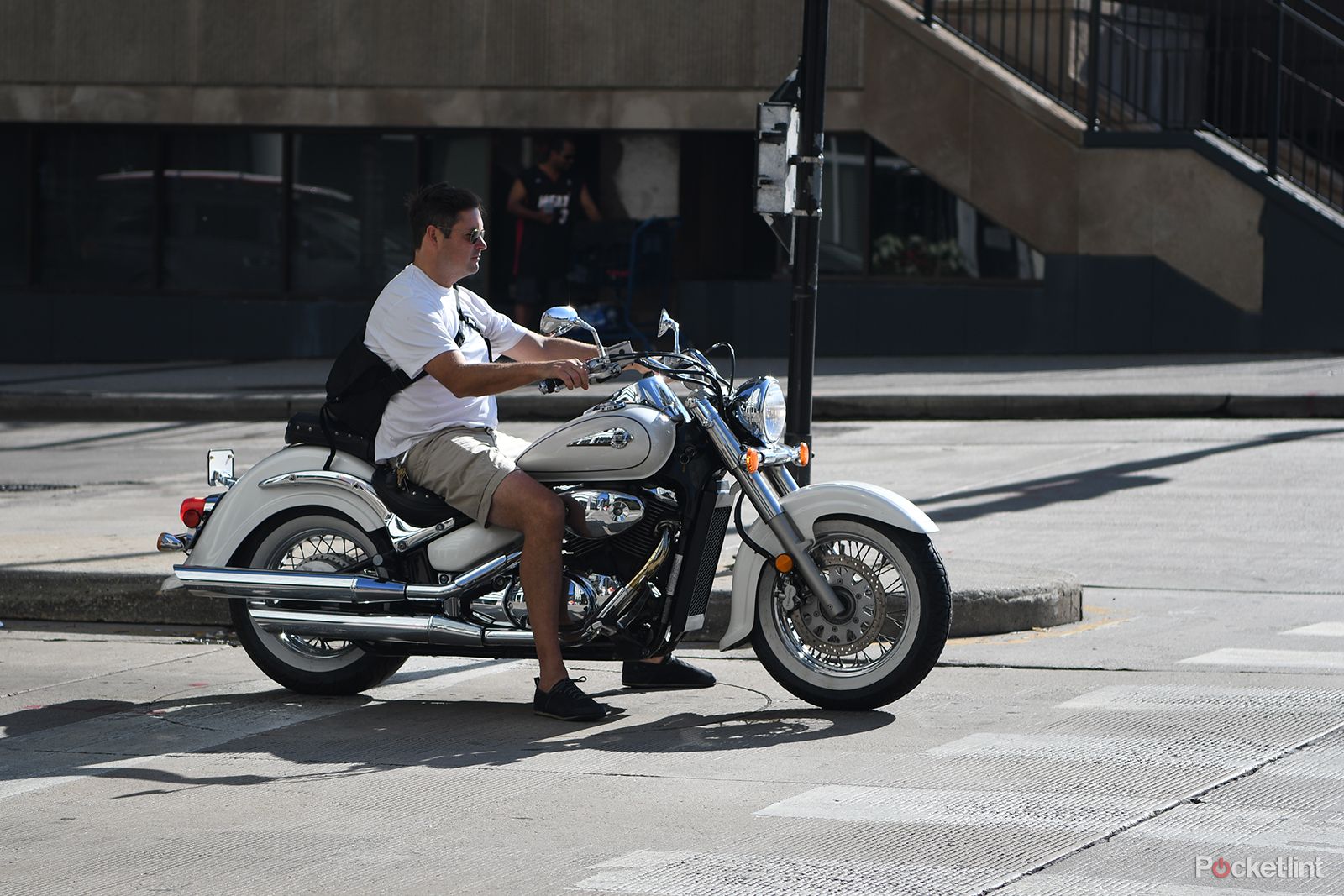
Whether using single or continuous AF we've been mighty impressed with the accuracy and speed of the D500. From shooting in dim-lit bars without flash (the camera is sensitive to -4EV), through to bikers speeding down the street, this is one capable and versatile DSLR system that rarely falters.
Our only small moan, perhaps, is the location of the rear toggle/joystick to make autofocus point adjustments. It's a bit of a reach, although will feel familiar to current Nikon users - and at least we didn't knock it by accident when in the hand.
Nikon D500 review: New-wave features
With the advance of technologies we've seen all kinds of new features in cameras, which have slowly - and oh so slowly - started to trickle down into DSLR cameras. Principal to those is touchscreen technology, a typical go-to for compact system cameras and many high-end compact cameras too. And now it's the D500's turn to offer the power of touch.
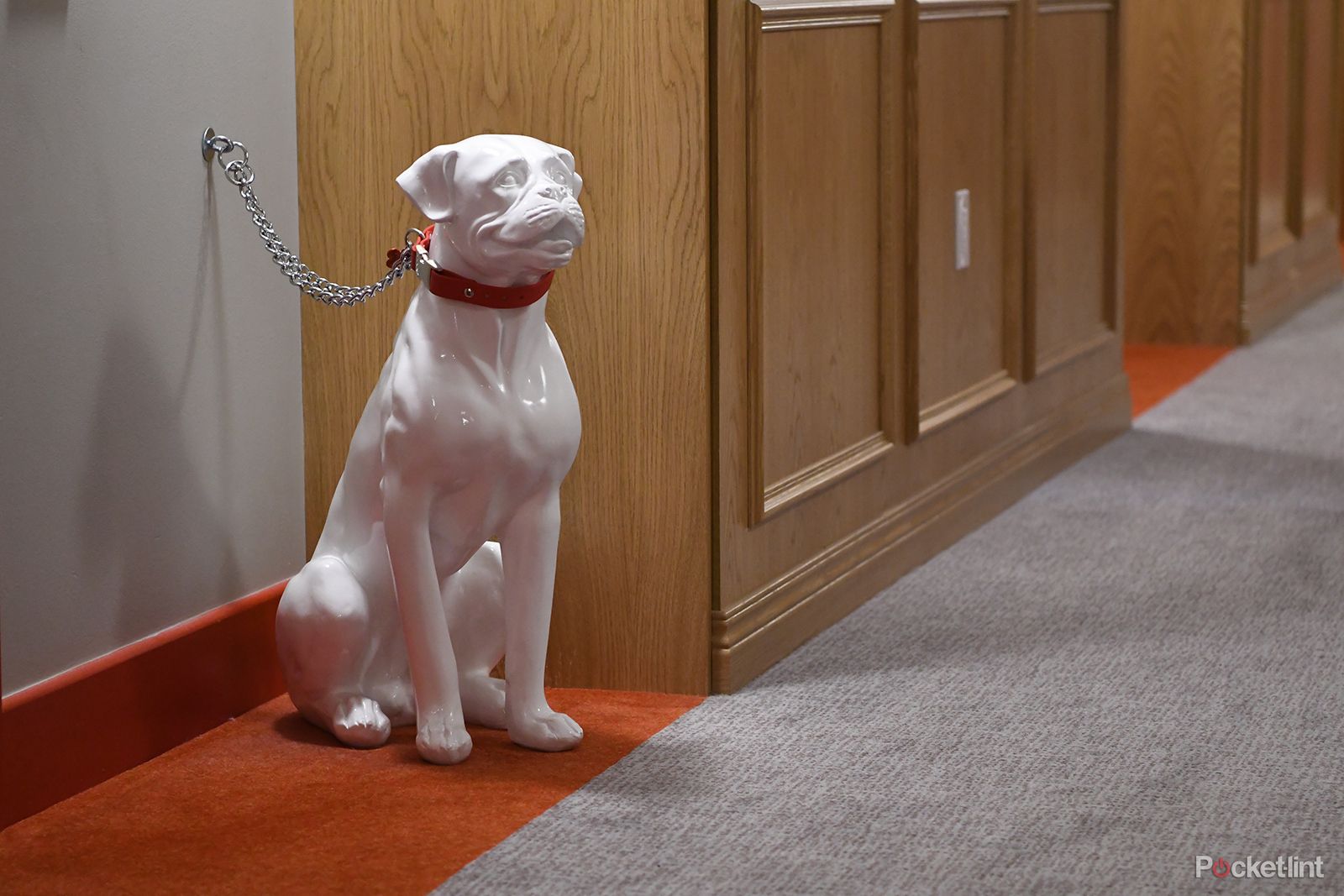
Or, partially. The D500's 3-inch screen responds well to touch, but it can only be utilised in active shooting, i.e. when in live preview or during video capture. That's fine, but there's no option to use it to swipe through or touch menu options, which feels like a missed opportunity - even if it was customisable to then turn it off as desired.
Autofocus in live preview is far faster than in older generations of Nikon DSLRs, thanks to a new 180-pixel metering sensor which can be utilised to better recognise subjects and points of contrast. Despite being faster, however, it's not perfectly accurate and will often hunt to find final focus - this is an area where compact system cameras are much better.
Like its Nikon D750 cousin, the D500 also implements a tilt-angle LCD screen. We've used it almost every time we've utilised live view, so used to such a feature we are these days. And while we would like to see this kind of screen in more DSLR cameras, there are actually better implementations of it: take a look at the full variable screen on the Pentax K-1, for example, or some of the side-positioned vari-angle screens of Canon's lineup.
Nikon D500 review: Design tweaks
Design-wise, the D500 is otherwise a well proportioned DSLR, that will seem familiar to Nikon users. Its one major shift of controls is the ISO button moving to behind the shutter - which, again, is more Canon-esque, but of considerable use (although a press-and-hold to make adjustments in this position is a little fiddly).
As that ISO button has moved, other buttons have jostled around the body compared to many other Nikon cameras. The customisable function button (Fn2 in this instance), now found to the rear left, sees the info button slide along the rear of the camera body. It's all logical.
Another small but brilliant addition to the feature set are light-up buttons. Finally. Simply push the on/off toggle beyond its on position and not only will the top plate light up, but so will the left-hand side buttons (not the right-hand ones, such as info and live view).
In addition to that LCD screen is a viewfinder that, thanks to 1.0x magnification, produces a large image to the eye for added precision and judgement. What you see is what you get too, as its coverage is 100 per cent for edge-to-edge framing. Spot on.
Nikon D500 review: Image quality
Beneath that weather-sealed body the D500 has a new 21-megapixel sensor, which sees resolution slide slightly compared to the Nikon D7200 for the sake of speed and larger pixels to aid with heightened sensitivity. Not that the camera's extended ISO 1,640,000 sensitivity (“Hi5”) is as high as the D5's bonkers extended ISO 3,280,000 option. At this point we should point out the extended “Hi” settings are all far-reaching well beyond their useful quota and, ultimately, are only there as a headline grab.
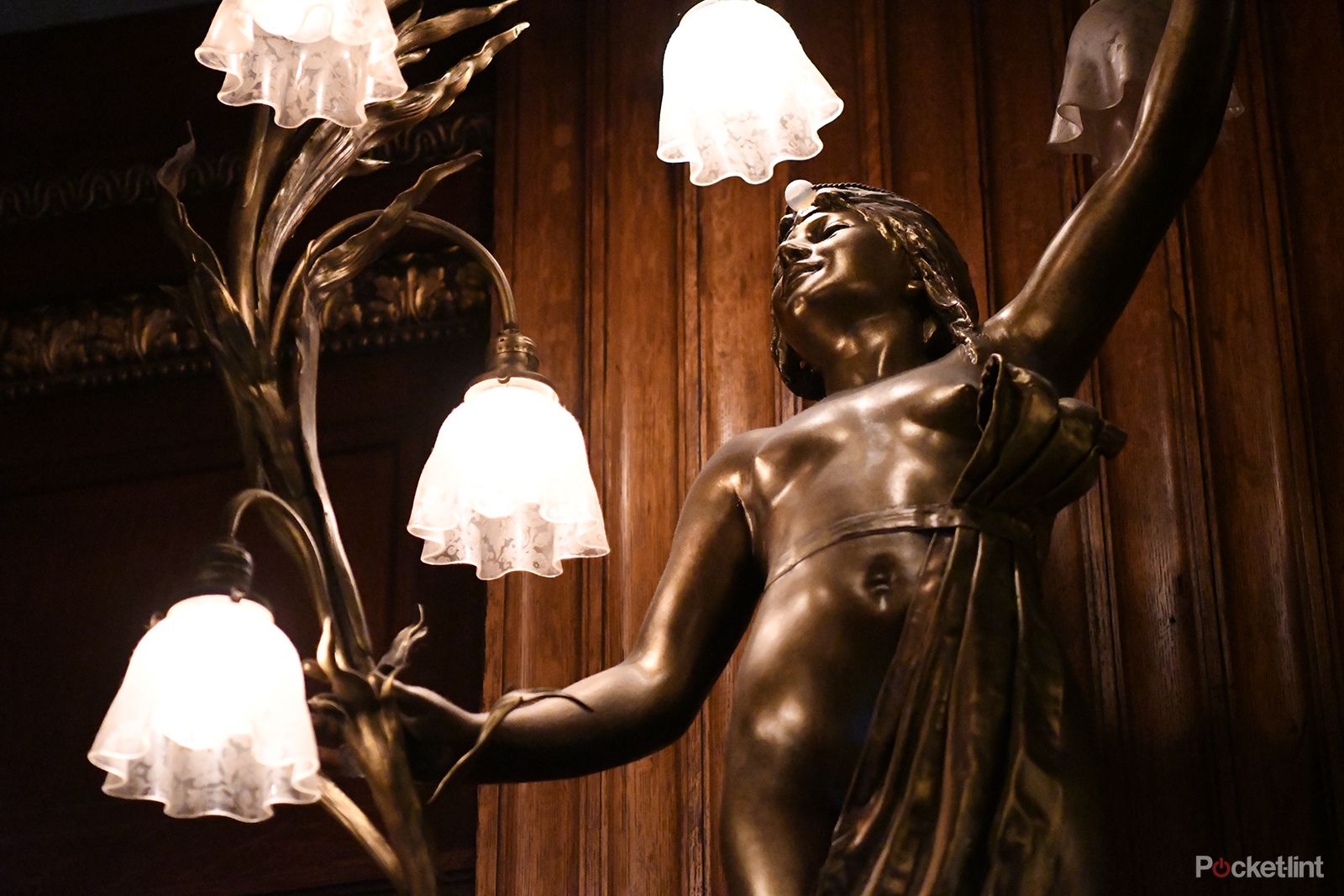
But that's not to rubbish the D500's abilities when it comes to high-ISO shooting. When grabbing some exuberant lights in a San Franciscan bar, the ISO 14,400 selection looks better than you'd get in daylight from phone cameras, for example. Even ISO 18,000 of the bar behind holds enough detail to remain legible. It's impressive.
And that's the top-end of the ISO range. Go the opposite direction and the level of clarity at the lowest ISO 100 setting is exceptional. Shooting at f/2.8 or f/4.0 to enhance that blurred background and we've achieved some great-looking shots - from pugs to birds, even sea lions - that look every bit professional.
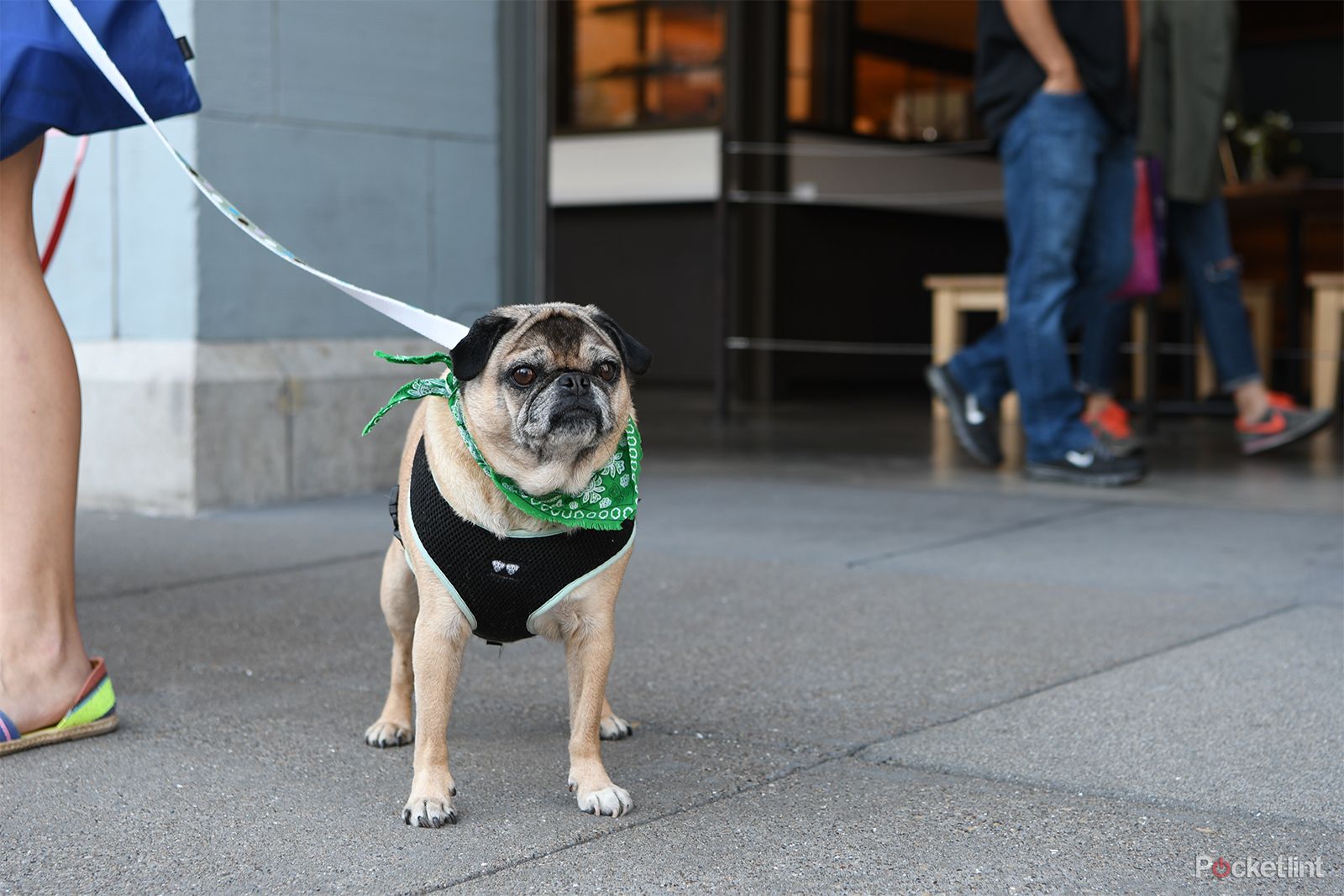
Ok, so the blurred background potential of an APS-C sensor - or DX format, as Nikon calls it - isn't quite as capable as a full-frame sensor, as per the D5, but the 1.5x crop factor associated with the D500 has its payoffs: one, the D500 is smaller; two, it's cheaper; and, three, that added zoom reach might be deemed advantageous if you're shooting far-away subjects.
We've found that new metering sensor to be capable for a variety of subjects, except for when the majority of the frame is one tone - such as when shooting pictures in an art gallery against white walls, which required exposure compensation and/or metering type adjustment, as predicted.
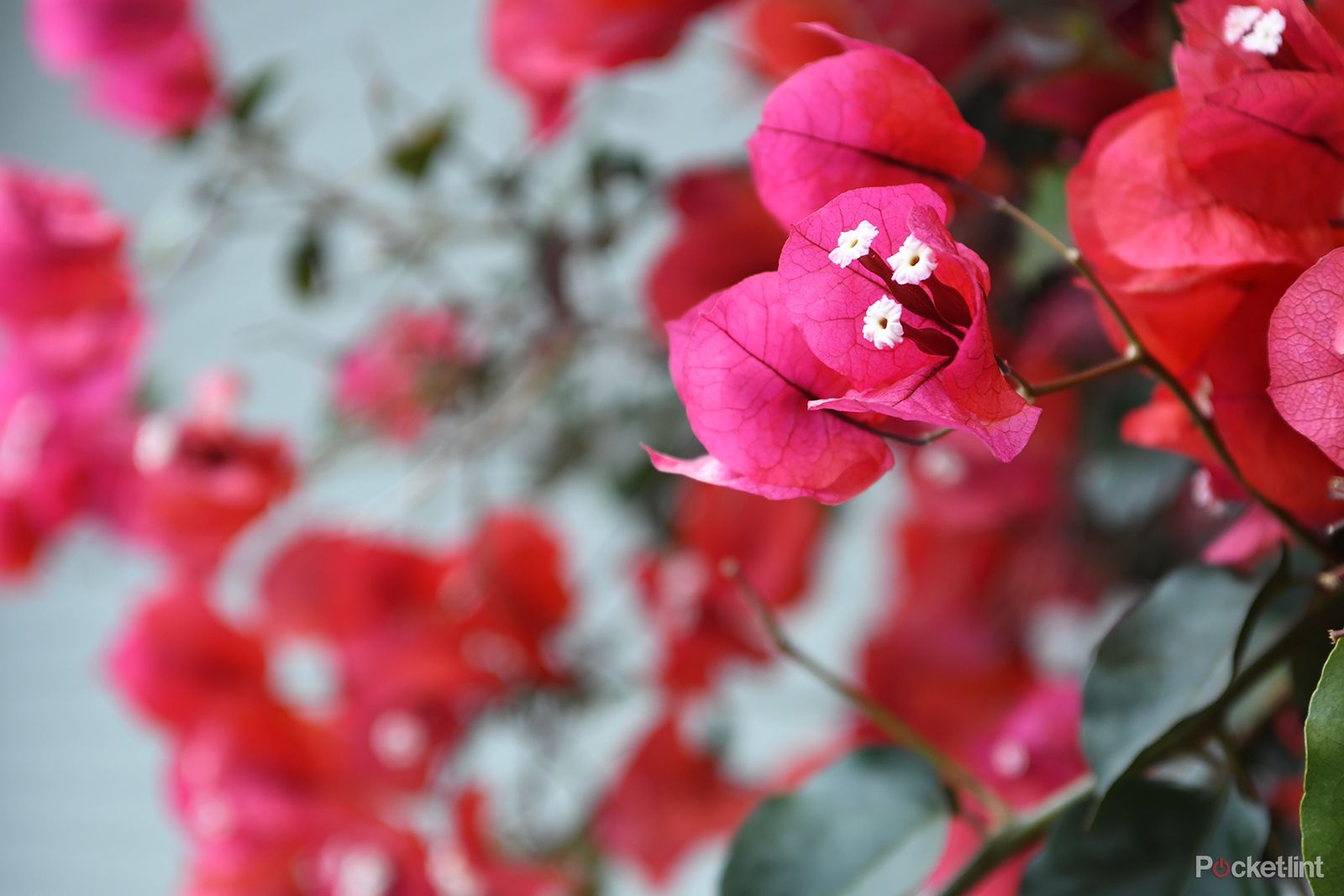
Colours look real too, while rarely pushing things to excess. The occasional exception is with reds/pinks which can be too saturated. But that's a small thing, and not as issue in raw shots.
Nikon D500 review: Performance and video
Another big push is in the D500's buffer ability, which exceeds that of many competitors. Assuming you have a decent xQD card in tow, the camera can suffer through 200 raw files at its full 10fps burst mode without quitting.
The point about that, though, is that you'll need an xQD card. The D500 does also accept CompactFlash - it's got one slot for each type - but, again, you'll want the fastest possible cards to make the most out of this camera. No CFAST compatibility here, which, thus far, has only been used by Canon.
Videographers might find the mix of two card formats a nuisance, too. And seeing as Nikon produces the D5 in multiple formats to your card preference, it's a shame that the D500 doesn't follow suit with multiple options. Can't have it all at this price point we suppose.
Still, videographers will be more than happy with the capabilities of the D500, which elevates the company's previous standings. Sure, Nikon was the first company to introduce a DSLR with video capabilities, back in D90 era, but Canon and other makes have quickly superseded the brand - the D300S maxed out at 720p24, which sounds like a relic of the past these days.
Not so the D500. It can capture 4K resolution footage at up to 30fps, from which you can save 8-megapixel JPEG images should you so wish. For the pros the ability to record to either memory card or external recorder via HDMI will come as a bonus, plus other high-end features like zebra stripes.
The Nikon D500 is certainly a contender for the best APS-C camera made to date. There are only some small gaps, such as unnecessary extended "Hi" ISO settings, slight hunting in the live view autofocus, but otherwise its awesome autofocus system and all-round capabilities are second to none.
- Global Home
- Global Network
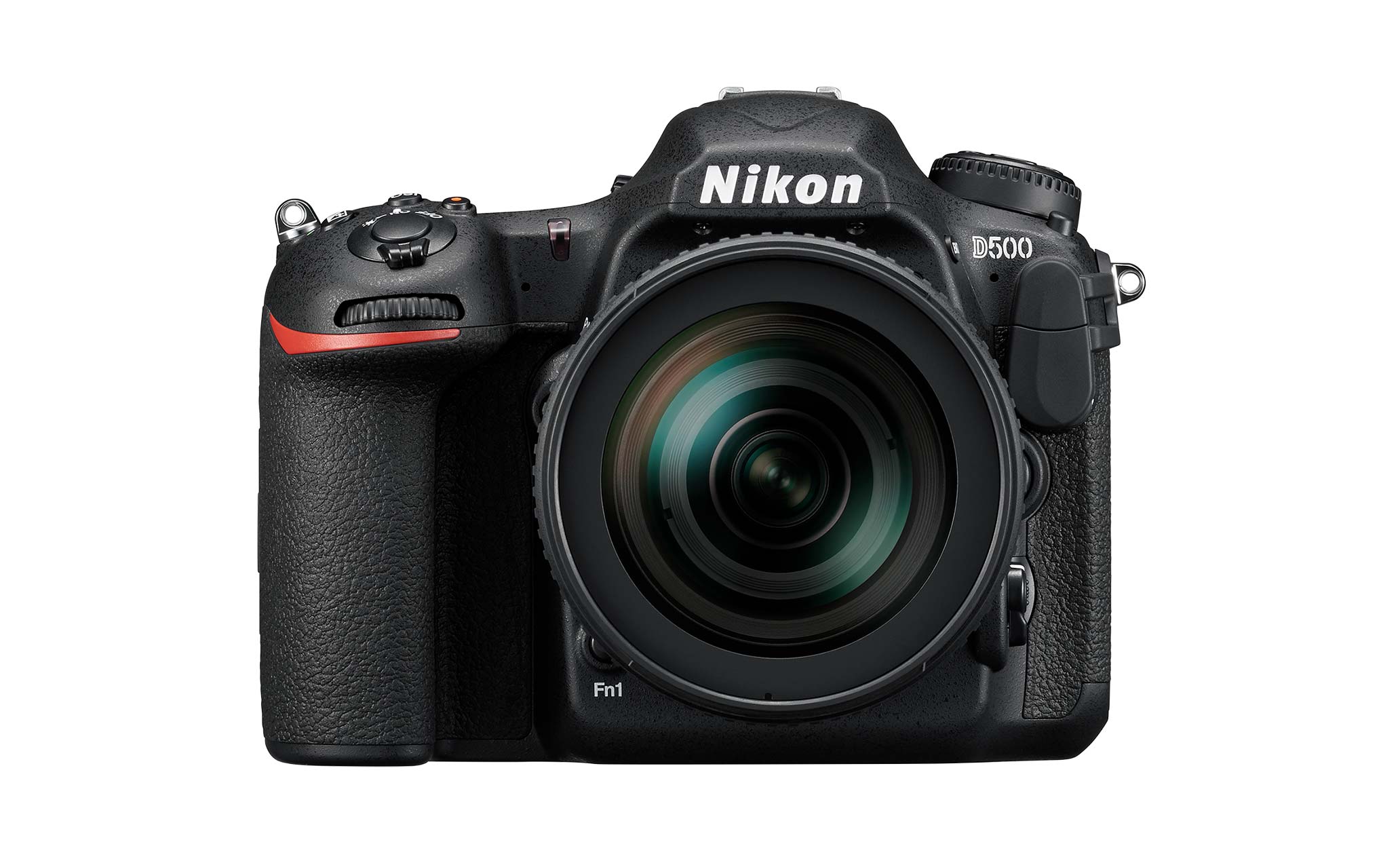
- 20.9 mega-pixels
- 100-51200 ISO
- 153 AF points
- Powerful new 153-point AF system delivers superior subject acquisition performance across a wider range of situations
- Approx. 10 fps continuous shooting (up to 200 shots in 14-bit lossless compressed RAW) captures decisive, split-second moments
- Compact, lightweight DX system offers outstanding agility, especially for telephoto shooting
- 4K UHD video (30p), suitable for professional productions
- New EXPEED 5 image-processing engine achieves superior image quality and sensitivity up to ISO 51200, expandable to Hi 5 (equivalent to ISO 1640000)
- Touch-screen, tilting 8-cm/3.2-in., 2359k-dot LCD monitor ensures comfortable shooting when composing from low or high angles
- SnapBridge support lets you connect the camera to a compatible smart device via built-in Wi-Fi ® and Bluetooth ®
Specifications
Type of camera, effective pixels, image sensor, white balance, bracketing types, supported languages, power source, tripod socket, dimensions / weight, operating environment, accessories.
- Nikon reserves the right to change the appearance and specifications of the hardware and software described in this material at any time and without prior notice.
- XQD is a trademark of SONY Corporation.
- The SD, SDHC and SDXC logos are trademarks of the SD-3C, LLC.
- The Bluetooth ® word mark and logos are registered trademarks owned by Bluetooth SIG, Inc., and any use of such marks by Nikon Corporation is under license.
- PictBridge is a trademark.
- HDMI, the HDMI logo and High-Definition Multimedia Interface are trademarks or registered trademarks of HDMI Licensing, LLC.
- Wi-Fi ® and the Wi-Fi logo are trademarks or registered trademarks of the Wi-Fi Alliance ® .
- N-Mark is a trademark or registered trademark of NFC Forum, Inc., in the United States and/or other countries.
- Other products and brand names are trademarks or registered trademarks of their respective companies.
- Specifications and equipment are subject to change without any notice or obligation on the part of the manufacturer.
Digital SLR Cameras

Our expert, award-winning staff selects the products we cover and rigorously researches and tests our top picks. If you buy through our links, we may get a commission. Reviews ethics statement
Nikon D500 review: The D500 scores on almost all counts
Fast and flexible, the Nikon D500 is one of the best dSLRs you can buy for under $2,000.

After 6 years neglecting the power APS-C action photographer, Nikon released the mostly impressive D500 dSLR, the little sister to the pro full-frame D5 . With the same autofocus and metering systems as that model, a high-sensitivity 20.9-megapixel CMOS sensor, a large tilting touchscreen and 4K video, it hits most of the essential targets for a camera in its class. Only a couple of flaws knock it slightly off course.
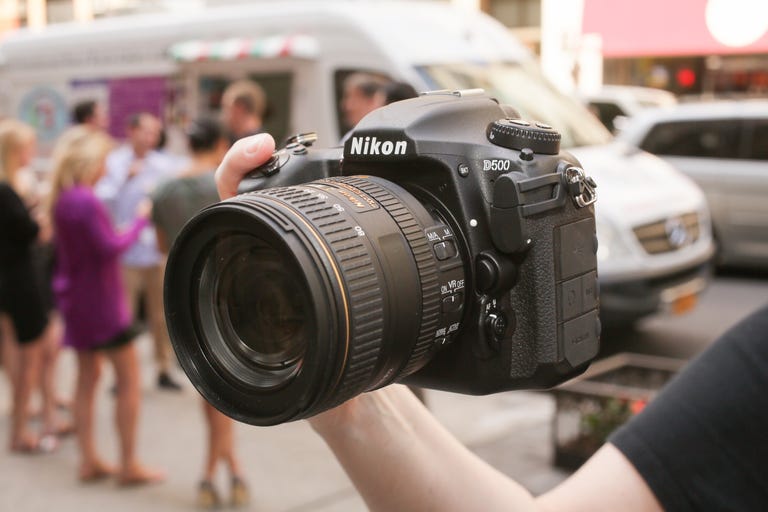
The Bottom Line
The D500's body runs $2,000 (£1,730, AU$3,500); the camera also comes in a kit with the DX 16-80mm f2.8-4mm lens for $2,600 (£2,480, AU$4,500). Unlike a lot of kit lenses I've seen, this one's pretty good, and has a useful general-purpose focal-length range equivalent to 24-120mm. The lens is sharp, with a reasonable maximum-aperture range that should match the needs of people who'd be buying the body and want something for routine situations.
Joining the 1-million ISO club
It takes more than just raw speed to optimize a camera for continuous shooting. You need the ability to take decent photos at high sensitivities. That's the only way you can use action-stopping fast shutter speeds and sharpness-maximizing narrower apertures under a lot of conditions; most activities don't take place in bright, direct sunlight. The D500 delivers a maximum sensitivity of ISO 1,640,000 -- highest in its price range -- though the camera's native range stops at ISO 51200, leaving five stops in the expanded range.
Nikon D500 full-resolution photo samples

JPEGs look clean through ISO 6400. At ISO 6400 you can still process the raws to obtain more detail, though the trade-off is a lot of "grain" and hot pixels in dark areas. Between ISO 12800 and ISO 102400 (Hi 1) in JPEGs you can see some smearing and processed color noise, but it still retains modest amount of detail. Beyond that, you can still get recognizable photos at small sizes. Processing the raw files doesn't help much; I suspect Nikon's performing some in-camera wizardry to produce what it does. Overall, though, the similarly priced Nikon D750 , with its full-frame sensor, still produces better photos
The color rendering and white balance are excellent. Its default Standard Picture Control increases contrast and you lose some highlight and shadow detail, and midtones are compressed, but the occasional hue shift is minor.
The D500 is the first camera to bring 4K video to a consumer-priced dSLR, and the quality is quite good for an APS-C sensor; sharp, with a solid dynamic range and the same excellent color. You can see a lot of noise in shadows above ISO 6400, but overall it's peachy.
Analysis samples
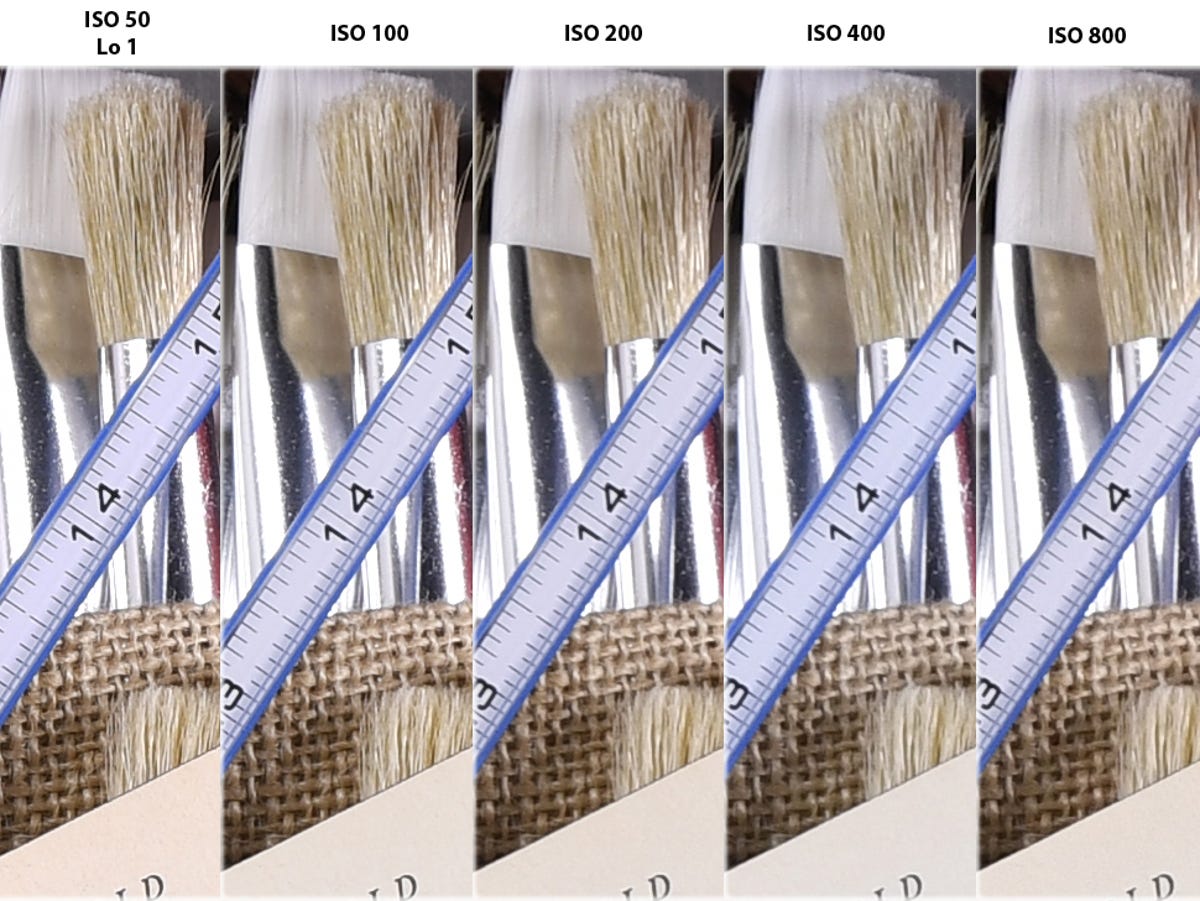
JPEGs look sharp and clean in the low ISO sensitivity range.
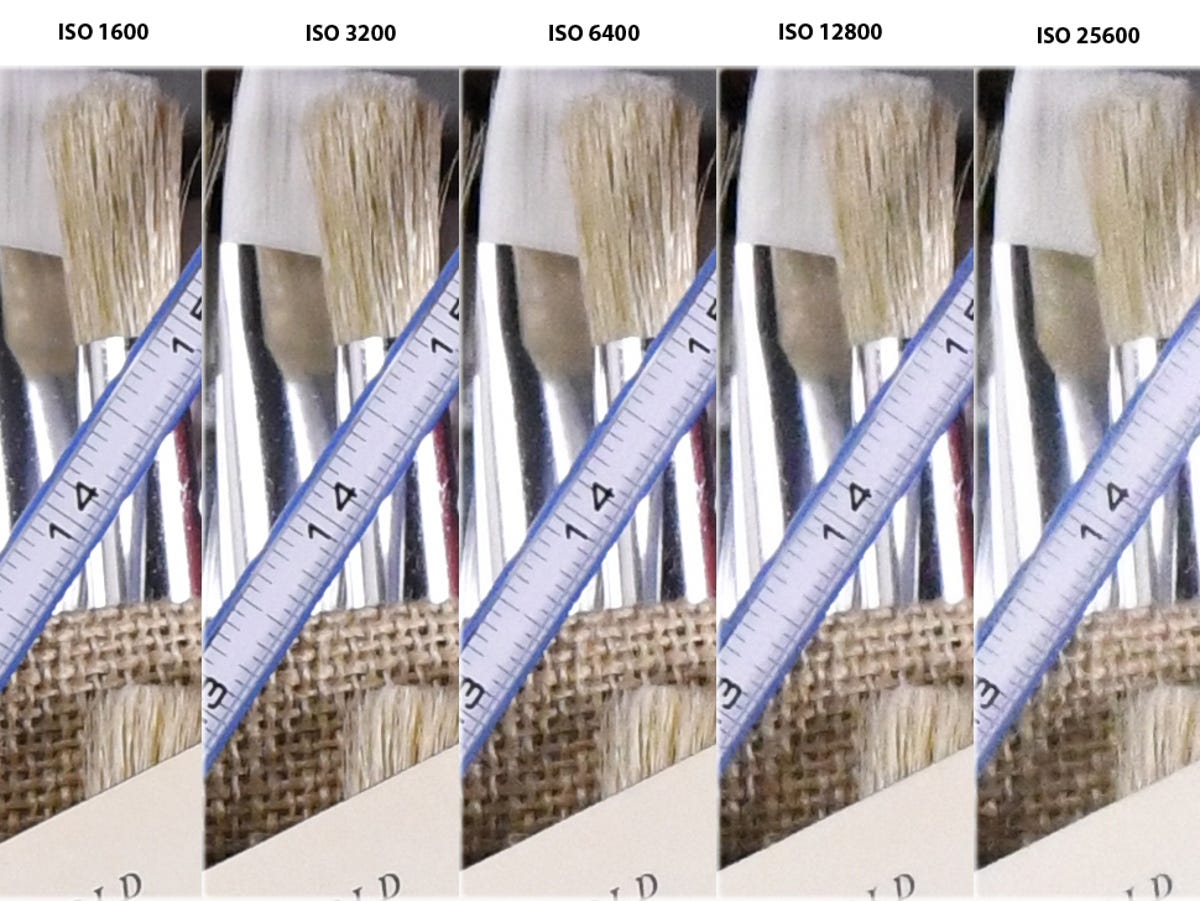
Despite the stratospheric ISO sensitivity claims, JPEGs are only clean through about ISO 6400, though depending upon the scene and lighting you may get pretty good results through ISO 25600.
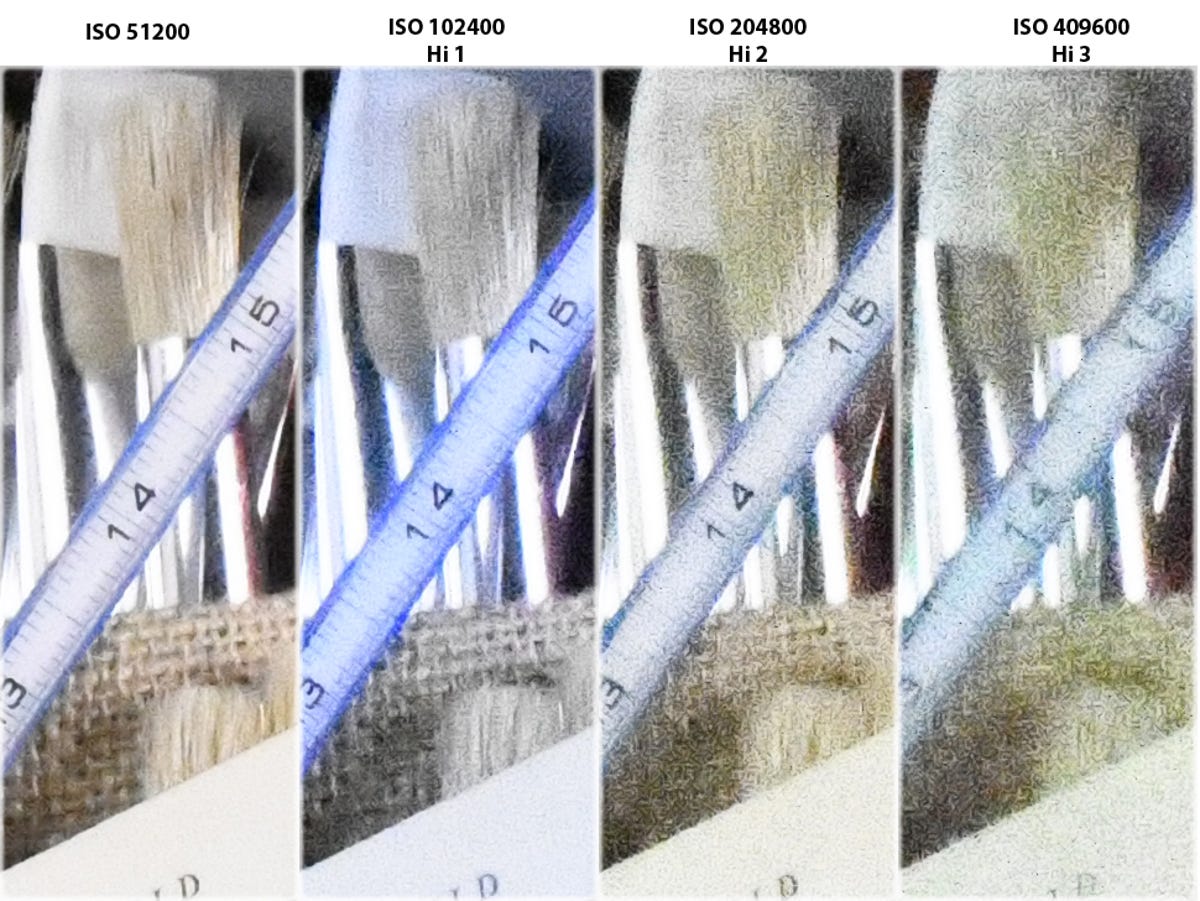
You don't want to venture into the expanded sensitivity ranges often, but they'll serve if you're desperate in low lighting. There's an odd white-balance shift in both raw and JPEG files at ISO 102400.
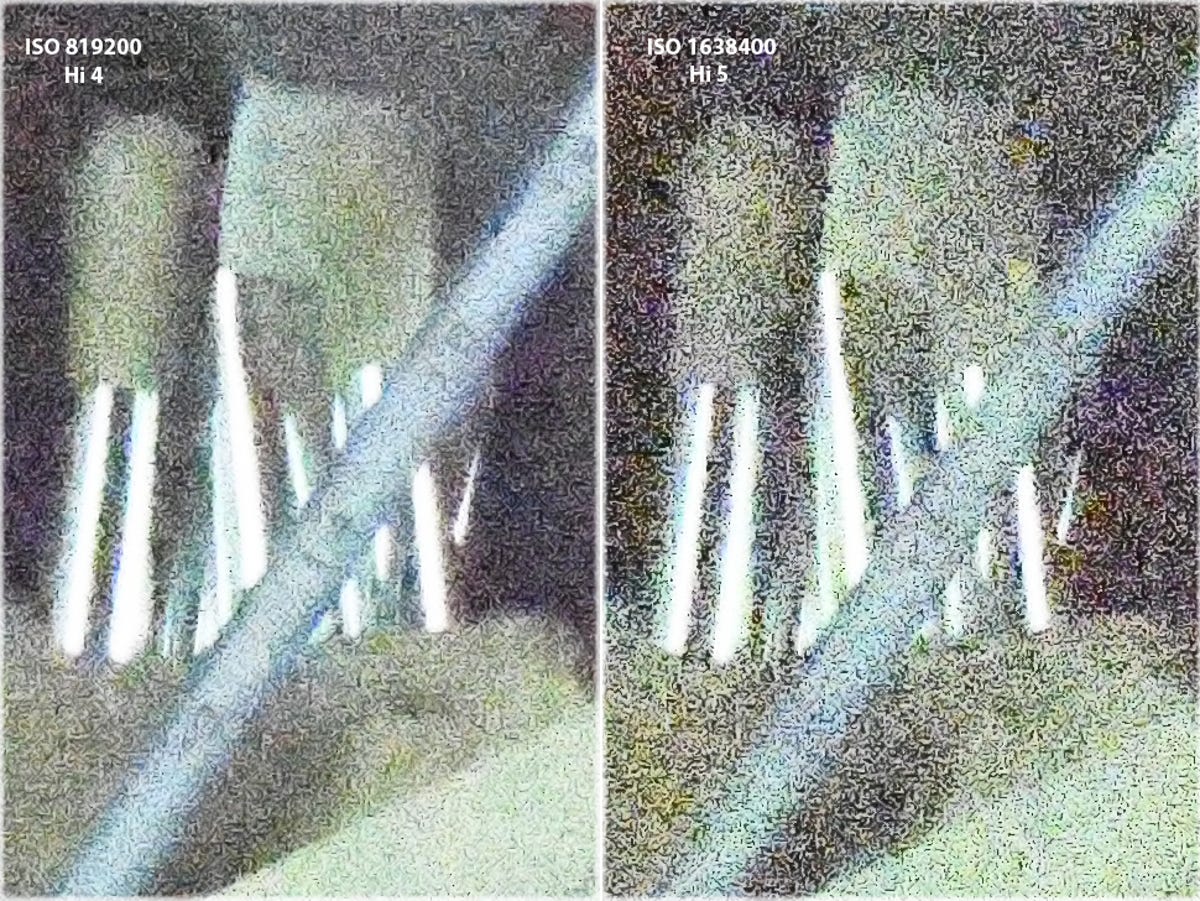
In dim light the highest ISO sensitivity images look much better than our test shots, but you still don't want to use them at 100 percent.
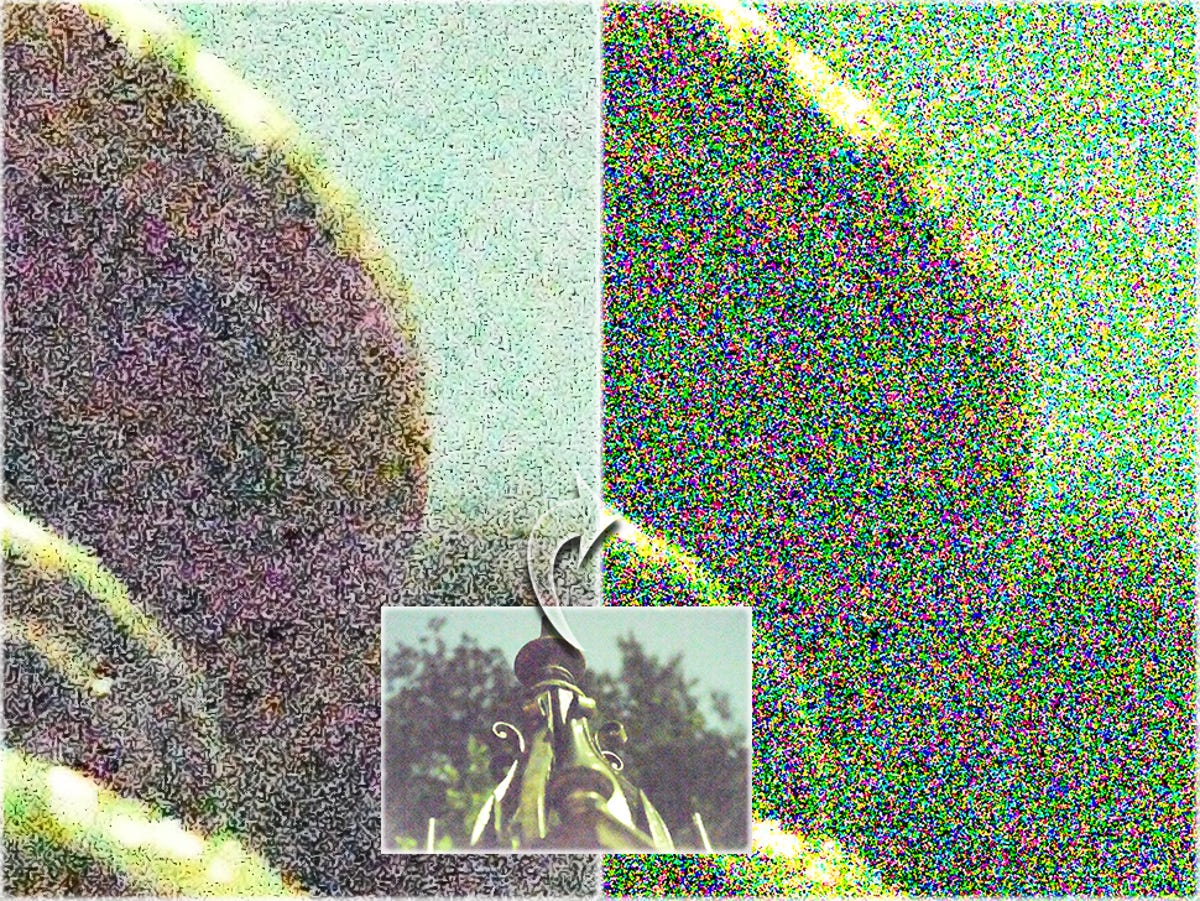
I'm impressed that Nikon can produce a recognizable image from this noisy mess at its Hi 5 sensitivity, equivalent to ISO 1638400. (JPEG on left, unprocessed raw on right.) In the expanded ranges, the JPEG processing delivers better results than you can probably get with raw processing, so if you enter that territory then change the in-camera settings to help keep from blowing up the highlights.

The D500 delivers excellent color reproduction and white balance under most conditions.
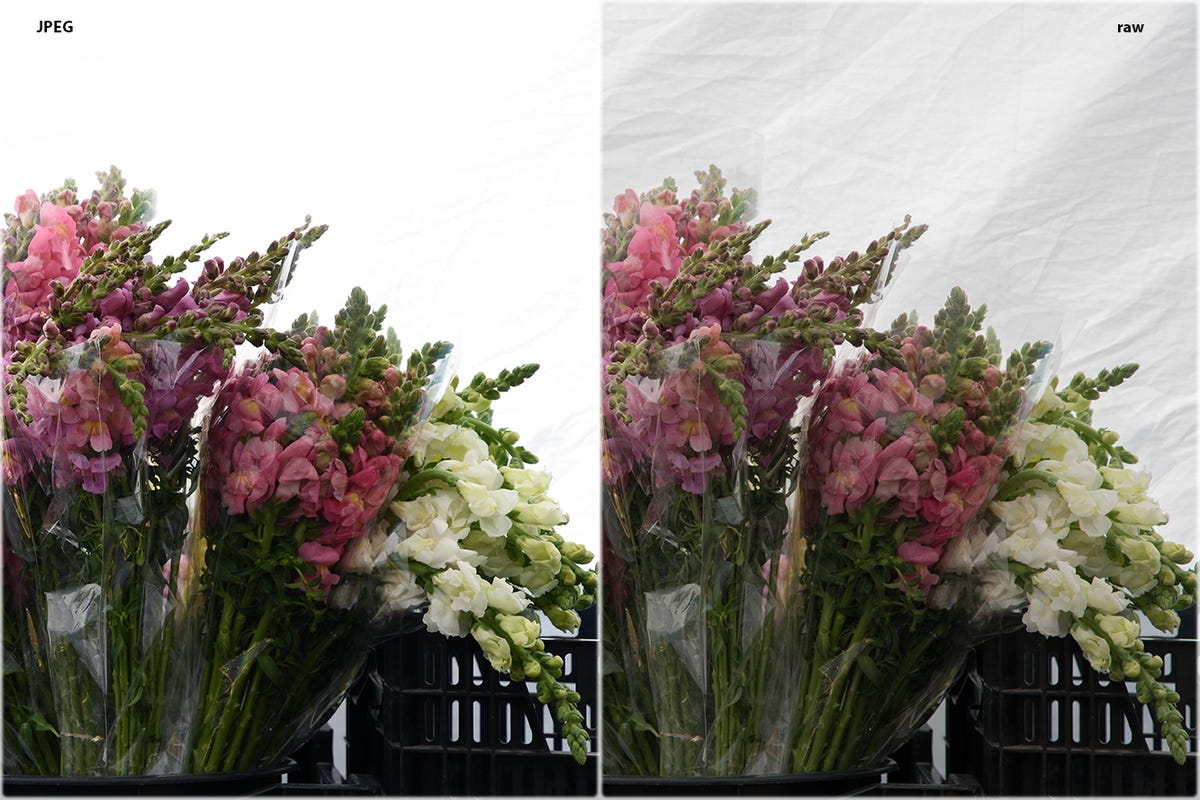
The camera's tonal range is pretty good, with a reasonable amount of recoverable highlight and shadow detail.
Rat-a-tat-tat
It's fast. Really fast for its price class, with concomitantly fast and accurate autofocus. For single shots, the cheaper Canon EOS 7D Mark II performs about the same (our charts overstate small differences in performance). Part of the slight lag stems from the 16-80mm lens, which is reasonably speedy but doesn't drive fast enough to keep up.
At continuous shooting, however, with both autoexposure and continuous autofocus enabled, the D500 sustains a rate of 10.7 frames per second for an unlimited number of JPEGs and more than 40 raw+JPEG shots to the XQD card before slowing; with an SD card, the rate is a still-nothing-to-sneeze-at 10fps.
And the autofocus keeps up quite well -- unsurprising given that it has the same AF system as the D5 -- though you really have to customize it to the type of action for best results. The camera can focus in really dim conditions, too. There's a one-shot exposure lag (for instance, if a bicyclist moves from light to shadow the first shot in the shadow was usually underexposed) but that's typical in cameras that support AE in maximum-speed burst.
Continuous shooting seemed to eat up the battery life and it depleted faster than I expected, but that may have been caused by the 90-plus degrees F temperature when I tested outdoors (that's 32 C for the rest of the world). Battery life is still pretty good, though. I can also attest that the dust-and-weather-sealed body is impervious to sweat.
The one blot on the D500's speed record is its Live View autofocus, which is pretty slow: the shot lag in good light is about 1.3 seconds. And the continuous AF in Live View when shooting video isn't great. It hunts too much and feels too ratchety. I didn't try all the settings, though, so it's possible there's a combination that adjusts more smoothly and quickly. The display does support touch focus, though, which compensates somewhat.
Shooting speed
- Shutter lag (typical)
- Shutter lag (dim light)
- Typical shot-to-shot time
- Raw shot-to-shot time
- Time to first shot
Continuous-shooting speed
Almost everything you need.
The camera's sturdy and comfortable to hold for long periods, with an intelligent control layout and a big, bright viewfinder. It has 4 banks of Nikon's typical array of customizable settings.
Its feature set has most everything you need in this class of camera. That includes a mic and
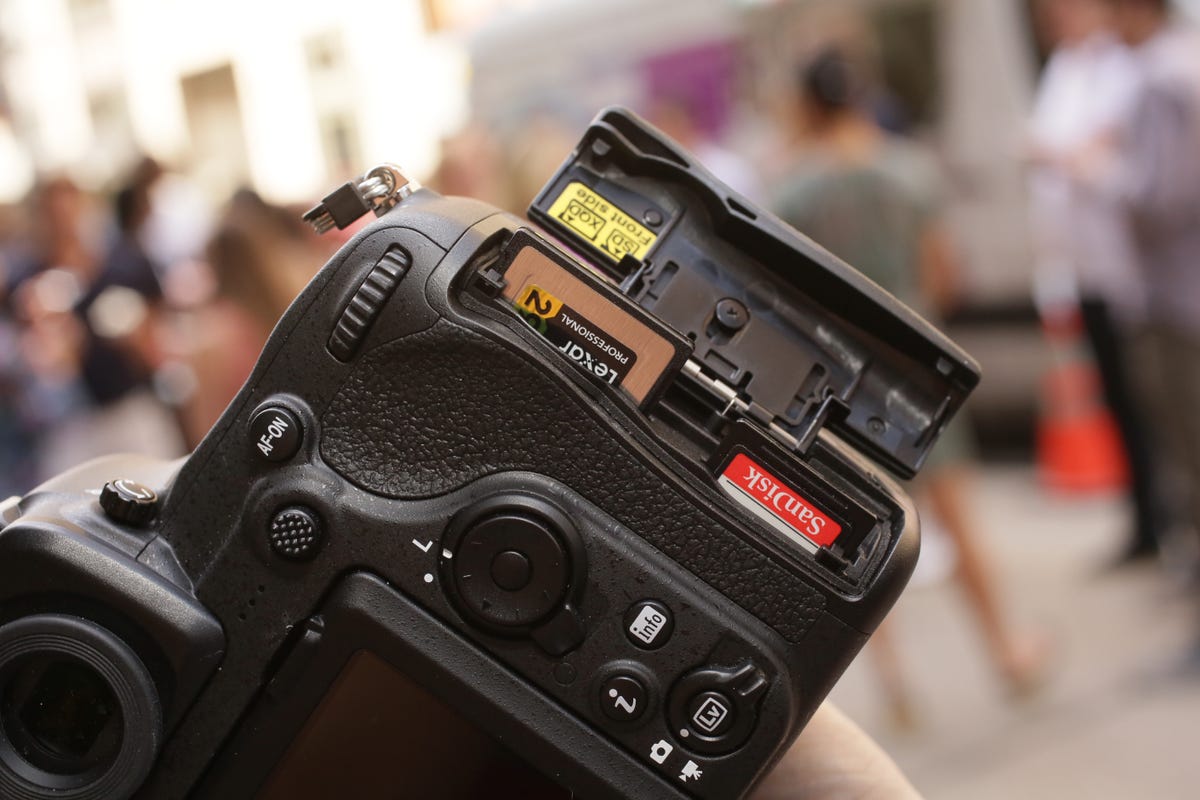
The D500 has two card slots, XQD and SD. The XQD provides noticeably faster performance for continuous shooting.
The camera's only real weakness is its wireless operation. Snapbridge is Nikon's branding for its wireless file transfer system, but I think the company spent more time and money on the branding than it did on the implementation. Though the D500 adds Bluetooth for a persistent, low-power wireless connection, the app isn't even robust enough for consumers much less the advanced users of this camera. (And I had to delete it from my phone because even disabled it was draining the battery.)
It seems like it's predominantly intended as a utility for uploading photos to Nikon's redundant file-sharing service. The remote shooting is really lame -- it's just a shutter. And the iOS app isn't even slated to come out until August. As Nikon has perpetually lagged in its wireless implementation, I don't have high hopes for improvement.
The Nikon D500 is 95 percent of a terrific camera. I enjoy photographing with it, the image quality is excellent for its sensor class, the feature set has all the essentials plus a bit more and it's fast in most shooting situations. For action stills and video it's the best dSLR for the money. I just wish it had a grown-up wireless implementation and faster Live View operation.
Comparative specifications
Score breakdown.
Nikon D500 review
A solid dslr with great image quality.
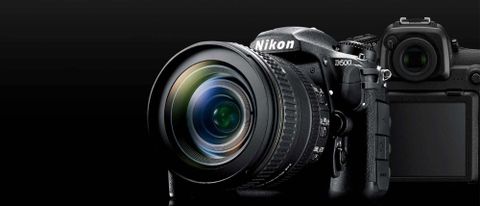
Tom's Guide Verdict
With its speedy performance and top notch image quality, the Nikon D500 is a great option for enthusiasts and prosumers who want to step up their game.
Excellent image quality
Responsive performance
Good low light capabilities
Dual card slots
Built-in time-lapse
Cropped 4K video
Less than stellar video/Live View autofocus
Limited touchscreen functionality
Why you can trust Tom's Guide Our writers and editors spend hours analyzing and reviewing products, services, and apps to help find what's best for you. Find out more about how we test, analyze, and rate.
Image Sensor: 20.0MP APS-C CMOS Storage Media: SD/SDHC/SDXC and XQD Image Stabilization: via OIS lenses Display: 3.2-inch touch LCD ISO: 100-51,200 (expandable to 1,640,000) Max video resolution: 4K UHD 3,840 x 2, 160/30 and 24 fps Shooting Speed: up to 10fps Wireless/Bluetooth/NFC: Yes Ports: 10-pin remote terminal, HDMI, USB, Stereo microphone and headphone jacks Battery life (CIPA): 1,240 Size (body): 5.8 x 4.6 x 3.2 inches Weight: 26.9 ounces, body only
Sitting at the top of Nikon’s DX (APS-C) DSLR line, the Nikon 500 is a solid option for enthusiasts and semi-pros alike. It’s also a great back-up for professionals shooting full-frame who want a smaller and lighter but highly capable second camera. Sports and wildlife photographers, regardless of expertise, will benefit from its 1.5x crop and speedy autofocus.
Read the full review of the Nikon D500 to see why we’re excited about this camera (and a couple of things we’re not so thrilled about).
I tested the Nikon D500 under a variety of conditions using several different lenses including the kit AF-S DX NIKKOR 16-80mm f/2.8, 70-200mm f/2.8 and f/4 models), 200-500mm f/5.6 and, one of my all-time favorites, the lightweight 300mm f/4E PF ED VR. Check out our sample photos and videos below to see how well the Nikon D500 and these lenses performed, and why it’s one of the best DSLR cameras .
- Best photo editing software
- Save your images in the cloud with the best photo storage and sharing sites
Nikon D500: Price and availability
The Nikon D500 was introduced in 2016, and is still the company’s premier DX-series DSLR. The Nikon D500 is available starting around $1,500. A kit with the NIKKOR 16-80mm VR lens will set you back around $2,100. Both DX and FX format lenses can be used with the Nikon D500, so if you already have Nikon lenses, you’re ahead of the game.
Nikon D500 review: Design
At 5.8 x 4.6 x 3.2 inches and 26.9 ounces, the Nikon D500 isn’t the smallest or lightest DSLR on the market (that honor goes to the Lilliputian Canon EOS Rebel SL3 ) but compact enough for one-handed shooting with a short lens like the NIKKOR 50mm f/1.8. The solidly built camera body is also well-balanced even with telephoto lenses thanks, in part, to its deep grip and comfortable handhold.
A large, bright optical viewfinder features 100% coverage, and the ability to display grid lines on the viewfinder helps with composition and level horizons. With a -2.0 to +1.0m diopter adjustment, I was able to easily adjust the viewfinder to accommodate my eyesight with and without glasses.

The Nikon D500’s 3.2-inch touchscreen LCD is bright and clear. Unfortunately, the monitor’s touch capabilities are limited. It has touch focus and touch shutter, and can be used to scroll and zoom images in playback. To navigate menus, though, you’ll need to use the four-way controller. Not a huge deal but somewhat disappointing. And, rather than having a fully-articulated LCD, the D500’s monitor only angles up and down, which is also a bit disappointing. A top control panel provides an at-a-glance view of exposure settings, number of shots remaining, battery life, etc.
What’s not disappointing, though, is the D500’s dual card slots that accommodate SD and XQD cards. The secondary card slot can be configured to store overflow (when the primary card is full), backup (a shot-by-shot duplicate of the primary card) or to save RAW files to the primary card and JPEGs to the secondary card.
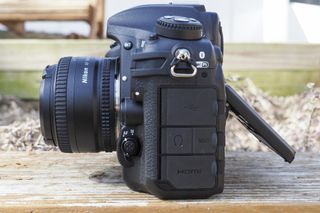
Nikon recently released a firmware update so the D500 — as well as other Nikon DSLRs — are compatible with the faster and higher capacity) CFExpress Type B cards (up to 2TB). Since CFExpress is the same form factor as the XQD, no changes to the camera body are required.
Typical for this class of camera, there’s no built-in flash. As expected, it has a hotshoe to attach an accessory flash when needed.
Nikon D500 review: Controls
Buttons and dials are plentiful and ergonomically positioned for quick access. Current Nikon users will feel comfortable with the external controls and menus. And once you set up the camera to your liking, you’ll rarely have to call up the easy-to-navigate menu system.
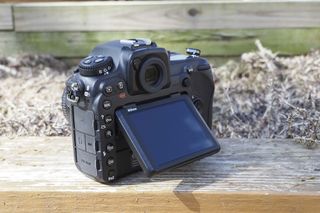
In addition to front and rear dials, the Nikon D500’s dedicated buttons include movie record, ISO and exposure compensation located just off the shutter release/power switch. The top left panel includes access to white balance, exposure mode, metering and quality along with a release mode dial (single, continuous low speed, continuous high speed and two quiet shutter release modes).
The rear panel is home to a long list of other buttons/controls including playback, menu, zoom, AF-ON, 4-way controller, a joystick for choosing AF points, Live View, function and info buttons. There’s also a depth-of-field preview button and another function button on the front of the camera. Better yet, many of the Nikon D500 controls—above and beyond the two function buttons—can be customized.

One of this camera’s cool features is its backlit buttons. Rotate the power switch to the little light bulb icon and you’ll be able to see the buttons and their identifying marks in the dark. This is a real bonus when shooting in low/no light, like in the press pit during fashion week.
The D500’s menu is long but well organized and easy to navigate, particularly if you’re a Nikon user. Press the question mark button to the left of the LCD for detailed and helpful explanations of many of the menu settings.
Nikon D500: Image quality
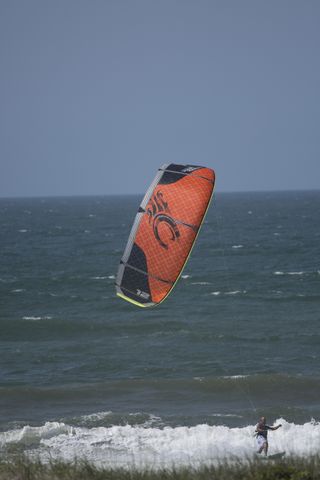
In a word, the Nikon D500’s image quality is excellent. In fact, I was as comfortable submitting this camera’s images to a wire service news agency as I was images from the higher end Nikon D4s and D850.
Colors were accurate and looked natural with just the right amount of saturation and sharpness, as shown in this image of a kitesurfer.
Even under mixed lighting that is usually found at fashion shows, auto white balance worked well. When the lighting temperature was known, I switched from auto white balance to the appropriate Kelvin temperature.
Auto white balance easily managed to keep these bridal gowns white even in this shot, which mixed natural light through the large windows and artificial light.

White balance can, of course, be adjusted in post processing when shooting Raw. In fact, the D500’s Retouch Menu offers in-camera Raw processing capabilities—including white balance adjustments.

Exposures were generally spot on both when shooting in program auto, semi-manual and manual modes. For the latter, the exposure meter was, for the most part, accurate. As always, the manual exposure mode allowed me to tweak the exposure when shooting in challenging conditions. Overall, dynamic range was quite good, as shown in this photo of a hawk with its dark and light markings.
Native ISO ranges from 100-51,200 and is expandable to a low of 50 and a high of 1,650,000. Even at ISO 6400, the D500 kept image noise to a minimum, as shown in the image below. At the same time, the camera maintained details and sharpness even at higher ISOs.
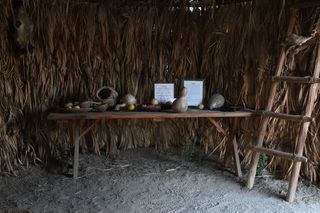
Nikon D500: Video
One of the first DSLRs to offer 4K video, the Nikon D500’s video options range from 4K UHD (30/24 fps), Full HD (60/30/24fps) to HD at 60fps. Complementing its video capabilities are a built-in stereo microphone, an external microphone jack as well as a headphone connector. You can also add an external monitor or recorder.
Image quality is quite good, with accurate colors and exposures. Detail capture is better than expected. Keep in mind, though, that 4K recording uses only part of the sensor. Add that crop factor to the camera’s APS-C 1.5x native crop and you need to figure in a little more than a total of 2x crop when choosing a lens. For example, a 14mm lens will deliver the same field of view as a 28mm lens, which may or may not be wide enough for the shot you planned.
The Nikon D500 did a good job of balancing the exposure in this high contrast scene. But given the tendency of the Nikon D500’s autofocus to occasionally search for focus and the fact that seabirds might fly into and out of the scene, I thought manual focus would work better here.
The Nikon D500 makes time-lapse video incredibly easy. Set-up is simple: just choose the interval (time between shots) and the total shooting time and you’re good to go. One of the really nice features is the “smoothing” option, which compensates for extreme changes in exposure during the recording. Once all the images are captured, the camera combines them into the final video like the one you see below.
Nikon D500: Performance
Solid performance is one of the Nikon D500’s strong suits. While many photographers have started gravitating towards mirrorless cameras for sports, the D500 can shoot up to 10 frames per second with swift and accurate autofocus (when shooting with the viewfinder). The D500 was responsive and capable of capturing these horses and riders in motion during a polo scrimmage.
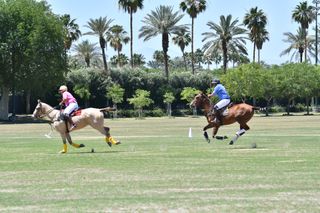
The Nikon D500 was also a great companion when shooting models on the runway at New York Fashion Week—regardless of lighting conditions.

And the camera was perfect for capturing fast moving kite surfers on a windy day.
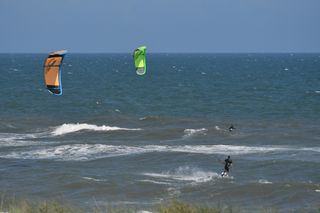
Autofocus is less speedy when using Live View but it’s unlikely that you’ll be using Live View to shoot action.
Shutter speeds are available from 1/8000th second to 30 seconds. There’s a Bulb setting for extra long exposures. The camera has a sync speed of 1/250th second and several self-timer modes. The latter include 2, 5, 10, 20 second durations with 1 to 9 exposures at various intervals.
Battery life is great, too, which is super important when you’re making use of its 10fps continuous shooting speed. The D500 can capture up to 1250 shots per charge and I never had to change batteries when covering two or three back-to-back fashion shows.
Nikon D500: Wi-Fi, Bluetooth and NFC
Nikon’s free SnapBridge app is available for iOS and Android mobile devices and works with Wi-Fi, Bluetooth and NFC. Set-up is relatively easy and while I’ve occasionally had some problems getting the app to work effectively, it’s generally smooth going.
As expected, the app facilitates transfer of images from camera to mobile device. Users can add copyright or other information (up to two pieces) to the images.
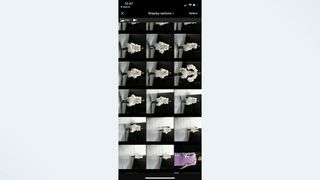
The app and mobile device can also be used to shoot remotely with options to shoot in program auto, shutter priority, aperture priority or manual exposure modes. Exposure compensation, ISO and white balance adjustments can be made directly from the app. It’s pretty typical when it comes to functionality and can be a real bonus when you want or need to share images in the field.
Nikon D500 review: Verdict
The Nikon D500 is one of my all-time favorite Nikon DSLRs thanks to its excellent image quality and performance. Enthusiasts and even newcomers who want to step up to a higher end APS-C camera can do so thanks to its more affordable price.
Although it’s more expensive, the 20 megapixel Canon EOS 7D Mark II ($1800) might be a good fit, especially if you already have a set of Canon lenses. You’ll have to give up 4K video but you’ll still get 10fps continuous shooting and gain better video AF and as well as a built-in flash.
But if you have Nikon lenses and are looking for a step-up camera that's a solid performer with great image quality, you can’t go wrong with the Nikon D500.
- Best cameras
- Best Nikon D-series accessories
Theano Nikitas is a freelance journalist and photographer. She's been writing about photography for more than 20 years, contributing countless reviews of cameras, lenses, accessories and software packages to Tom's Guide. Her work has also appeared in dozens of other magazines and websites, including CNET, DPreview, PopPhoto, Professional Photographer and Shutterbug.
I test AI chatbots for a living and these are the best ChatGPT alternatives
Criterion Channel launches 24/7 livestream — a binge-watching dream come true
EarFun Air Pro 3 review
Most Popular
By Kate Kozuch March 31, 2024
By Jason England March 28, 2024
By Anthony Spadafora March 28, 2024
By Jessica Downey March 28, 2024
By Michael Gowan March 28, 2024
By Lee Dunkley March 27, 2024
By Hunter Fenollol March 26, 2024
By Jason Cipriani March 25, 2024
By Andrew Hayward March 25, 2024
By Ryan Epps March 25, 2024
By Jason England March 25, 2024

Best lenses for safari photography
Our experts pick out the best lenses for safari in all major mounts, with a range of zooms for all budgets.
The quick list
Multi-mount, micro four thirds, how to choose the best lenses for safari, how we test lenses.

Multi-mount Sigma 150-600mm Sports Tamron 18-300mm Sigma 60-600mm
Canon RF 200-500mm EF 70-300mm
Nikon Z 24-200mm AF-S 200-500mm
Sony FE 100-400mm
Fujifilm XF100-400mm XF150-600mm
L-mount Lumix S 70-200mm
Micro Four Thirds Olympus 12-100mm Lumix G 35-100mm
How to choose How we test FAQs
The best lens for safari photography is not, despite what you may think, simply the longest telephoto you can find. Safari photography is about capturing both wildlife and scenery, and this means your best bet is finding a lens that can cover as much range as possible (as you don't want to be swapping every two minutes). As such, in this guide we've focused on telephoto zooms.
Historically, the best superzoom bridge cameras have been very popular with safari-goers ( Sony’s RX10 cameras are pretty clearly constructed with this audience in mind). However, for superior quality and performance, you're much better off with a mirrorless camera or DSLR, which will have a larger sensor.
in this guide to the best safari lenses, we’ve picked out a great variety of options for all the major mounts. We’ve included fantastic superzooms and telephoto zooms in an attempt to provide you with a broad, flexible range of options. These lenses all have different strengths and weaknesses, as we’ve discovered in our testing, but the one thing they all have in common is that we reckon they're the best safari lenses for each system right now.

Jon is one of our go-to specialists when it comes to all aspects of photography, from cameras and action cameras to lenses and memory cards. Here he looks at the best lenses for safari shoots.
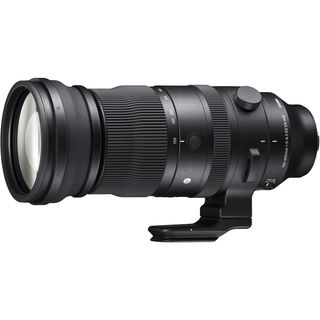
Best multi-mount
Available for both Sony E-mount and L-mount, this exceptional lens delivers a dream range for safari shooting, with speed, flexibility and weather sealing.
Read more below
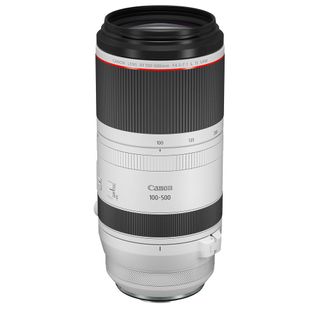
Best Canon mirrorless
If you're using a Canon RF mirrorless camera, the RF 100-500mm f/4.5-7.1L IS USM is our recommendation for safari shooting – well built, with great stabilization.
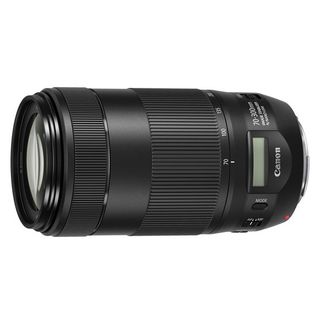
Best Canon DSLR lens
Adding a little more reach than a standard workhorse telephoto, the Canon EF 70-300mm f/4-5.6 IS II USM is great for safari shooting on DSLRs.
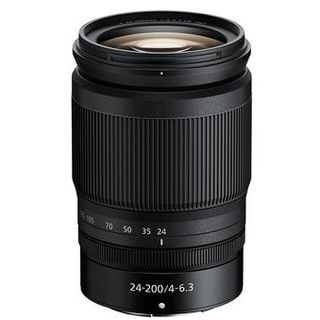
Best Nikon mirrorless
For Z-mount, the Nikkor Z 24-400mm lens will deliver excellent results for wildlife. It's stabilized and weatherproof, and delivers even more reach on DX-format cameras.
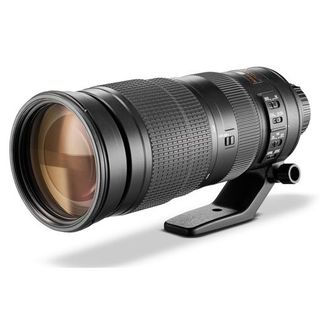
Best Nikon DSLR lens
For F-mount DSLRs, the Nikon AF-S 200-500mm lens delivers monster zoom reach and fast focusing. The constant f/5.6 aperture is also a welcome feature.
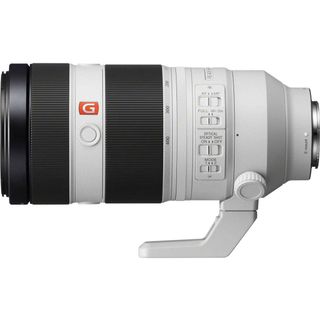
Best Sony FE
While Sony users have plenty of choice, we particularly rate this capable 100-400mm lens, which excels at producing bokeh-licious wildlife portraits.
Load the next products ↴
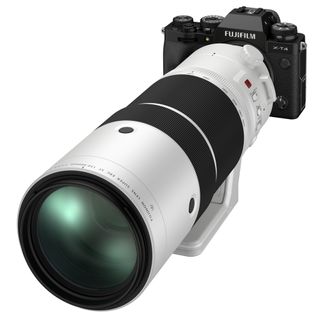
Best Fujifilm X
The longest telephoto for Fujifilm X-mount, this lens can even be extended further with teleconverters! Its image quality is brilliant too, and it's stabilized.

Best L-mount
If you're looking for a dedicated L-mount lens for safari, this workhorse Panasonic is – for our money – better value than its more expensive f/2.8 stablemate.
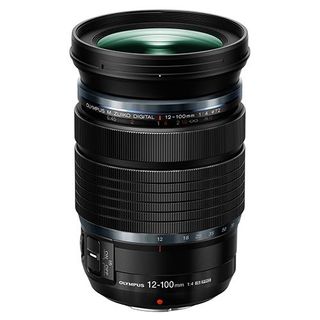
Best Micro Four Thirds
With a focal range equivalent of 24-200mm, this lens for Micro Four Thirds is built to high quality standards, inside and out. We especially like the gorgeous metallic construction.
The best lenses for safari photography in 2024
Why you can trust Digital Camera World Our expert reviewers spend hours testing and comparing products and services so you can choose the best for you. Find out how we test.
First up, we've grouped together some spectacular lenses that are available for multiple mounts, including Sony E, L-mount and Fujifilm X. If you're using any of these mirrorless systems, this is an excellent place to start.
Sigma 150-600mm Sports

1. Sigma 150-600mm f/5-6.3 DG DN OS Sports
Our expert review:
Specifications
Reasons to buy, reasons to avoid.
Covering a focal expanse from telephoto 150mm to super-telephoto 600mm, the Sigma 150-600mm f/5-6.3 DG DN OS Sports is a very popular format of lens. We could have filled this list with 150-600mm lenses if we wanted, but we picked this update to a very popular DSLR lens, the old Sigma 150-600mm f/5-6.3 DG OS HSM | Sport for Canon EF and Nikon F mounts. This time it fits Sony E-mount mirrorless, with a version also available for L-mount full-frame cameras made by Panasonic, Sigma and Leica.
Tack-sharp throughout its zoom range, the Sigma 150-600mm f/5-6.3 DG DN OS Sports is designed for speed and flexibility. It focuses fast, delivers great-looking bokeh in its defocused areas, and it’s also comprehensively weather-sealed, which is good news if the heavens decide to open mid-safari. If you’re using an L-mount camera, we’d say it’s essential. If you’re on Sony E-mount, you have a few more competitive options (see our full Sony section further down the page).
See our full Sigma 150-600mm f/5-6.3 DG DN OS Sports review .
Tamron 18-300mm
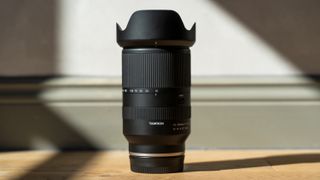
2. Tamron 18-300mm f/3.5-6.3 Di III-A VC VXD
Want to whip from expansive scenic shots to super-close-up images of wildlife within a moment? A good superzoom lens like the Tamron 18-300mm f/3.5-6.3 Di III-A VC VXD is just the thing. It’s available for two APS-C systems – Fujfilm X and Sony E-mount (the A6000 cameras) – meaning it delivers an effective focal range of 27-450mm. It’s got quality where it counts too, particularly in the centre of images. There’s some drop-off at the edges, as you’d expect with a lens of this type, but nothing that’s going to ruin your images. Autofocus speeds impress, meaning you shouldn’t have to worry about wildlife making a run for it while your camera hunts for focus. It weighs just 620g, too. See our full Tamron 18-300mm f/3.5-6.3 Di III-A VC VXD review
Sigma 60-600mm
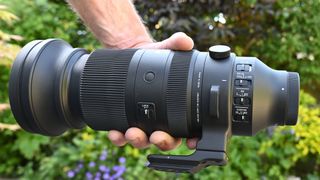
3. Sigma 60-600mm F4.5-6.3 DG DN OS Sports
A lens that weighs this much won’t be for everyone, that’s for sure. However, if you’re using full-frame Sony or L-mount cameras and want to cover your bases, the Sigma 60-600mm F4.5-6.3 DG DN OS Sports will do just that, running from standard focal length to super-telephoto. It impresses all across that zoom range too, with excellent sharpness and well-engineered handling despite the weight. It does feel a little weird using such a bulky lens at 60mm, but you get used to it. The stabilization is class-leading, providing up to 7 stops of effective compensation. Though bear in mind that the 105mm filter thread means you’ll have to fork out a sizable sum if you want even a simple protective UV filter. Check out our full Sigma 60-600mm F4.5-6.3 DG DN OS Sports review .
Here we've picked out the best Canon safari lens for both RF-mount mirrorless and good old EF-mount DSLRs – the latter of which can also be adapted to fit mirrorless cameras.
RF 200-500mm

4. Canon RF 100-500mm f/4.5-7.1L IS USM
Canon lenses with the ‘L’ designation in the name are designed with the utmost attention to quality. This means a lens like the Canon RF 100-500mm f/4.5-7.1L IS USM is built to last in all sorts of conditions, with a heat shield coating that means it can withstand ultra-hot weather (or ultra-cold, for that matter). The generous zoom range gives you a lot of shooting flexibility, with a smooth zooming action with speed that can be adjusted to taste. Its stabilization is very effective too (even more so with higher-end EOS R cameras like the EOS R5), meaning you can use slower shutter speeds and still get sharp shots. This is especially helpful when dealing with the somewhat pedestrian maximum aperture, which drops to a weak f/7.1 at the telephoto end. See our full Canon RF 100-500mm f/4.5-7.1L IS USM review .
EF 70-300mm

5. Canon EF 70-300mm f/4-5.6 IS II USM
The Canon EF 70-300mm f/4-5.6 IS II USM is an update to a popular lens, providing a little more reach than your average workhorse telezoom, at the cost of a slower maximum aperture. Image quality is gorgeous, and stays so even at the outer limits of the 300mm focal length, which is good news for safari shooters. The handling is great too – smooth and intuitive, with a useful digital information display for checking settings. Plus again there’s that L-series build, meaning the lens is capable of surviving a sudden downpour. If you’re using Canon DSLRs, whether APS-C or full-frame this is definitely a lens to consider adding to a safari kitbag – it’ll deliver great quality and flexibility without adding too much weight. See our full Canon EF 70-300mm f/4-5.6 IS II USM review .
Nikon shooters may be using Z-mount mirrorless cameras or F-mount DSLRs – so once again we've included here our favourite lenses for both systems. Remember that F-mount lenses can be adapted to fit Z-mount mirrorless cameras with an FTZ adapter (though not the reverse).

6. Nikkor Z 24-200mm f/4-6.3 VR
This lens is compatible with both full-frame and APS-C Nikon Z cameras – and you get different advantages with each one. Use it with the full-frame models like the Z5 or the Z7 II and its built-in Vibration Reduction stabilizer can work in tandem with the in-body VR on those cameras to deliver highly effective stabilization. Or, use it with DX-format cameras like the Nikon Z50 to bump the effective focal range up to 26-300mm. Either way, you’re getting a travel-friendly zoom that’s equally capable at capturing scenic vistas and close-up wildlife images. S ee our full Nikon Z 24- 200mm f/4-6.3 VR review .
AF-S 200-500mm
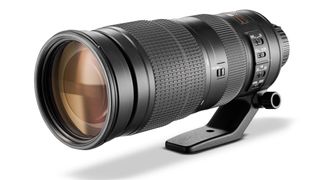
7. Nikon AF-S 200-500mm f/5.6E ED VR
Reasonably priced for a telephoto zoom of its kind, the Nikon AF-S 80-400mm f/4.5-5.6G ED VR offers tremendous value for users of Nikon DSLRs – which are still some of the most popular wildlife cameras out there. Its image quality is top-notch, delivering clean and sharp images right the way through the zoom range, and both the autofocus and stabilization are consistently effective. We would have liked a full suite of weather seals – there’s a rubber mount around the gasket, but it’s not overall comprehensive. You’ll probably be okay in light drizzle, but it might be worth investing in a rain cover if you’re anticipating any torrential downpours. See our full Nikon AF-S 200-500mm f/5.6E ED VR review .
Thanks to Sony's historic openness to third-party lens manufacturers, Sony E-mount users are particularly spoilt for choice. All of the lenses in our top Multi-mount section are compatible with Sony E cameras to some degree (two for full-frame and APS-C, one for just APS-C). However, if you'd prefer a Sony-made lens, here is our top pick.
FE 100-400mm
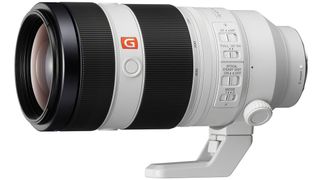
8. Sony FE 100-400mm f/4.5-5.6 G Master OSS
Sony’s ‘G Master’ designation is conferred only on its top-end lenses, ones that deliver an exceptionally high standard of optical quality. As such, while the Sony FE 100-400mm f/4.5-5.6 G Master OSS is undoubtedly an expensive lens, it’s also a beautiful piece of kit. One thing it particularly excels at is creating images with attractive bokeh – meaning the quality of the defocused areas of images. This means if you want to create portrait-style images of wildlife with a shallow depth of field, it’s a good choice of lens. Also, if you need more reach, it can be used with Sony’s 1.4x and 2.0x teleconverters (just remember that the extra focal length comes at the cost of reduced maximum aperture). See our full Sony FE 100-400mm f/4.5-5.6 G Master OSS review .
Fujifilm's APS-C X cameras are a brilliant choice for safari photographer, and the telephoto lens range for the system has expanded in recent years. Here are our top picks for Fujifilm X safari shooting. Remember also that the Tamron 18-300mm f/3.5-6.3 Di III-A VC VXD in our Multi-mount section is available for Fujifilm X-mount.
XF100-400mm
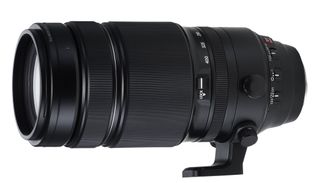
9. Fujifilm XF100-400mm f/4.5-5.6 R LM OIS WR
With the release of highly capable cameras like the X-H2S and the X-T5 , Fujifilm has signified it is playing in the big leagues. This weighty lens is a perfect partner for those who want to use Fujifilm’s flagship cameras for challenging pursuits like safari photography. It may be heavy for an APS-C lens, tipping the scales at just under 1.4kg and stretching out to 270mm in length when fully zoomed, but it delivers a focal range equivalent to 152-609mm in full-frame terms. It’s thoroughly weather-sealed as well.
See our full Fujifilm XF100-400mm f/4.5-5.6 R LM OIS WR review
For a while it was the longest lens you could get for the X-mount – however, it has been eclipsed by a more recent release…
XF150-600mm

10. Fujifilm XF150-600mm F5.6-8 R LM OIS WR
The APS-C crop factor of Fujifilm X plays into this lens’s strengths, transforming it into an amazing 229-914mm equivalent in full-frame terms. To get the same thing on a full-frame Sony system you’d need a 600mm lens and a 1.4x teleconverter, which makes both the price and the modest maximum aperture of this lens look a bit more reasonable. The XF150-600mm also features a ‘sensing and control system’ to help control for movement when using it at full zoom, and it really does make a difference to hand-held shot sharpness. This is definitely helpful as you’ll already have a bit of softness to contend with at the maximum focal length. Not enough to ruin shots, but it’s worth being aware of.
See our full Fujifilm XF150-600mm F5.6-8 R LM OIS WR review
L-mount shooters should note that, like Sony E users, they can also take advantage of the Sigma 150-600mm f/5-6.3 DG DN OS Sports and Sigma 60-600mm F4.5-6.3 DG DN OS Sports lenses featured in our Multi-mount section. For more options, read on as we pick our favourite dedicated L-mount lens for safari.
Lumix S 70-200mm
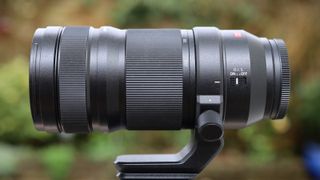
11. Panasonic Lumix S Pro 70-200mm f/4 O.I.S.
We love this lightweight telephoto zoom for L-mount cameras – in many ways, we prefer it to the flashier, professional Lumix S Pro 70-200mm f/2.8 . The f/4 version is much, much lighter and still delivers spectacular sharpness with impressive consistency throughout its zoom range. In good news for safari shooters, the lens is comprehensively weather-sealed, and the focus ring features a clutch mechanism that allows you to switch between auto and manual focus with a simple push-pull action. The stabilization is also highly effective – when paired with a compatible system in a Panasonic Lumix S camera, it can deliver up to six stops of effective compensation, helping keep images sharp while shooting handheld.
Read our full Panasonic Lumix S Pro 70-200mm f/4 O.I.S. review .
Micro Four Thirds lenses are compatible with Panasonic Lumix G, Olympus and OM System cameras. The 2x crop factor of the smaller sensor means the stated focal length of the lens is effectively doubled, giving you some serious telephoto reach in a compact lens body.
Olympus 12-100mm
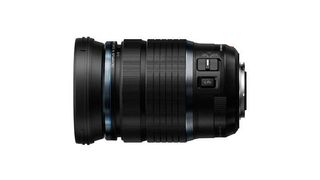
12. Olympus M.Zuiko Digital ED 12-100mm f/4 IS Pro
This lens is something of a wonder, and though the 200mm maximum equivalent reach may not be enough for all safari goers, its sheer image quality and supremely effective stabilization make it well worth considering for your kit bag. The ‘PRO’ designation means it’s built to high quality standards inside and out – so as well as the excellent optical quality, you also get a weather-sealed barrel, with a metallic construction and textured rings. This is one of the more ambitious lenses for Micro Four Thirds, and that is reflected in the price, which is higher than average for a lens in this class.
Lumix G 35-100mm
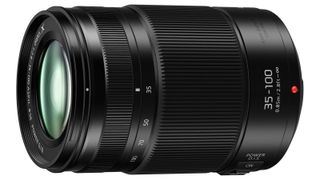
13. Panasonic Lumix G X Vario 35-100mm f2.8 II Power OIS
With the Micro Four Thirds crop factor, this lens delivers the workhorse focal length of 70-200mm, which is pretty good coverage for safari work. Plus, the compact size and affordable asking price mean it doesn’t have to be the only lens you take – this really is one of the key advantages of MFT. The Lumix G X Vario 35-100mm impresses in most categories, delivering very good sharpness at all focal lengths. It drops off a little at f/2.8, and the bokeh quality isn’t the smoothest, but when stopped down the lens delivers the goods, with color fringing and distortion basically nullified when combined with in-camera corrections. See our full Panasonic Lumix G X Vario 35-100mm review .
Naturally, safari photography shares a lot of DNA with wildlife photography – however, there are a few factors specific to shooting safari that will impact your lens choice. For one, the guided nature of a safari means you're likely going to be able to get closer to your subjects than you would if you were out on your own relying on bushcraft. For this reason, you don't necessarily need the kinds of ultra-long telephoto lenses that are the hallmarks of professional wildlife photographers – 600mm and 800mm lenses are probably going to overkill (which is good news for your bank balance).
You do need a bit of telephoto reach, and having a zoom is a good idea, since you're unlikely to be able to move much from your initial position. For this reason, many safari photographers favour standard workhorse telephoto zooms like 70-200mm, 100-400mm or even 150-600mm. This gives you plenty of range and flexibility.
Naturally, the wild animals you encounter are not going to pose obligingly for you, so a lens that focuses quickly is certainly an asset. Having stabilization is also going to help, as you won't necessarily be able to set up a tripod – and this also means you'll want to keep an eye on weight, as you may be hand-holding the lens for extended periods. Weatherproofing is also a good idea.
We test lenses using both real world sample images and lab tests. Our lab tests are carried out using the Imatest testing suite, which consists of custom charts and analysis software that measures resolution in line widths / picture height – a measurement widely used in lens and camera testing. We also take lenses out into the real world to get a feeling for how they perform, and whether they do everything their manufacturers claim.
What equipment do you need for safari photography?
As well as your camera and lens, there are a number of valuable photographic accessories worth taking along for safari photography. A good camera support is always going to be an asset – a tripod is great, or a monopod is also handy, and even a beanbag could potentially be a lifesaver as a place to rest your lens for steadier shots.
Otherwise, you shouldn't need to carry too much – flashguns are a no-no. Do remember some spare batteries and memory cards however, as you won't be able to stock up once you're out there.
Are bridge cameras good for safari photography?
If you're looking for a more affordable alternative to an interchangeable camera/lens system, then a bridge camera could be the way to go. These are essential SLR-styled compact cameras with big zoom lenses, and they are quite popular among safari enthusiasts. However, while they are cheaper and more portable than mirrorless or DSLR cameras, their smaller sensors do have an impact on image quality, particularly in terms of dynamic range. Check out our guide to the best bridge cameras to learn more.
Best lenses for bird and wildlife photography Best cameras for wildlife How to prepare for a safari or wildlife photography trip
Get the Digital Camera World Newsletter
The best camera deals, reviews, product advice, and unmissable photography news, direct to your inbox!
Jon spent years at IPC Media writing features, news, reviews and other photography content for publications such as Amateur Photographer and What Digital Camera in both print and digital form. With his additional experience for outlets like Photomonitor , this makes Jon one of our go-to specialists when it comes to all aspects of photography, from cameras and action cameras to lenses and memory cards, flash diffusers and triggers, batteries and memory cards, selfie sticks and gimbals, and much more besides.
An NCTJ-qualified journalist, he has also contributed to Shortlist, The Skinny, ThreeWeeks Edinburgh, The Guardian, Trusted Reviews, CreativeBLOQ, and probably quite a few others I’ve forgotten.
Related articles
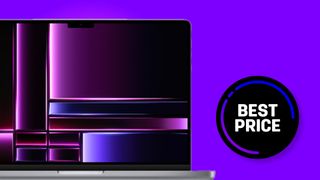

Current time by city
For example, New York
Current time by country
For example, Japan
Time difference
For example, London
For example, Dubai
Coordinates
For example, Hong Kong
For example, Delhi
For example, Sydney
Geographic coordinates of Elektrostal, Moscow Oblast, Russia
City coordinates
Coordinates of Elektrostal in decimal degrees
Coordinates of elektrostal in degrees and decimal minutes, utm coordinates of elektrostal, geographic coordinate systems.
WGS 84 coordinate reference system is the latest revision of the World Geodetic System, which is used in mapping and navigation, including GPS satellite navigation system (the Global Positioning System).
Geographic coordinates (latitude and longitude) define a position on the Earth’s surface. Coordinates are angular units. The canonical form of latitude and longitude representation uses degrees (°), minutes (′), and seconds (″). GPS systems widely use coordinates in degrees and decimal minutes, or in decimal degrees.
Latitude varies from −90° to 90°. The latitude of the Equator is 0°; the latitude of the South Pole is −90°; the latitude of the North Pole is 90°. Positive latitude values correspond to the geographic locations north of the Equator (abbrev. N). Negative latitude values correspond to the geographic locations south of the Equator (abbrev. S).
Longitude is counted from the prime meridian ( IERS Reference Meridian for WGS 84) and varies from −180° to 180°. Positive longitude values correspond to the geographic locations east of the prime meridian (abbrev. E). Negative longitude values correspond to the geographic locations west of the prime meridian (abbrev. W).
UTM or Universal Transverse Mercator coordinate system divides the Earth’s surface into 60 longitudinal zones. The coordinates of a location within each zone are defined as a planar coordinate pair related to the intersection of the equator and the zone’s central meridian, and measured in meters.
Elevation above sea level is a measure of a geographic location’s height. We are using the global digital elevation model GTOPO30 .
Elektrostal , Moscow Oblast, Russia

NS Energy is using cookies
We use them to give you the best experience. If you continue using our website, we'll assume that you are happy to receive all cookies on this website.

We have recently upgraded our technology platform. Due to this change if you are seeing this message for the first time please make sure you reset your password using the Forgot your password Link .
CFR600 Nuclear Reactor Pilot Project
Power Nuclear Reactor
Project type :
Sodium-cooled fast-neutron demonstration reactor
Xiapu, Fujian province, China
600MWe (1,500MWt)
Construction Started :
December 2017
Expected Completion :
Developer :.
China Institute of Atomic Energy
Project Gallery

The CFR600 nuclear reactor is being constructed in Xiapu, China. Image courtesy of China National Nuclear Corporation.
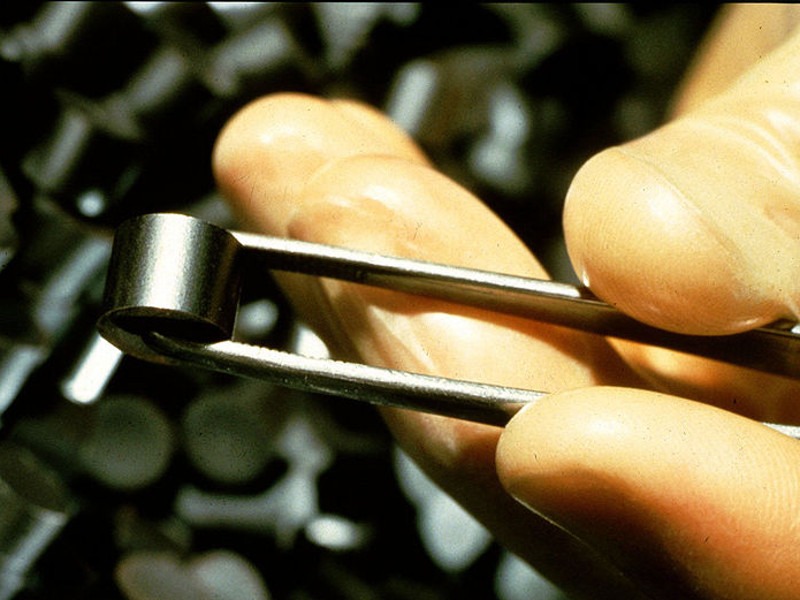
The TEVEL Fuel Company of Rosatom will supply nuclear fuel for the CFR600 nuclear reactor.
CFR-600 prototype reactor project background
Cfr-600 reactor technology, safety features of the cfr-600, fuel supply for the cfr-600.

Victor Mukhin
- Scientific Program

Title : Active carbons as nanoporous materials for solving of environmental problems
However, up to now, the main carriers of catalytic additives have been mineral sorbents: silica gels, alumogels. This is obviously due to the fact that they consist of pure homogeneous components SiO2 and Al2O3, respectively. It is generally known that impurities, especially the ash elements, are catalytic poisons that reduce the effectiveness of the catalyst. Therefore, carbon sorbents with 5-15% by weight of ash elements in their composition are not used in the above mentioned technologies. However, in such an important field as a gas-mask technique, carbon sorbents (active carbons) are carriers of catalytic additives, providing effective protection of a person against any types of potent poisonous substances (PPS). In ESPE “JSC "Neorganika" there has been developed the technology of unique ashless spherical carbon carrier-catalysts by the method of liquid forming of furfural copolymers with subsequent gas-vapor activation, brand PAC. Active carbons PAC have 100% qualitative characteristics of the three main properties of carbon sorbents: strength - 100%, the proportion of sorbing pores in the pore space – 100%, purity - 100% (ash content is close to zero). A particularly outstanding feature of active PAC carbons is their uniquely high mechanical compressive strength of 740 ± 40 MPa, which is 3-7 times larger than that of such materials as granite, quartzite, electric coal, and is comparable to the value for cast iron - 400-1000 MPa. This allows the PAC to operate under severe conditions in moving and fluidized beds. Obviously, it is time to actively develop catalysts based on PAC sorbents for oil refining, petrochemicals, gas processing and various technologies of organic synthesis.
Victor M. Mukhin was born in 1946 in the town of Orsk, Russia. In 1970 he graduated the Technological Institute in Leningrad. Victor M. Mukhin was directed to work to the scientific-industrial organization "Neorganika" (Elektrostal, Moscow region) where he is working during 47 years, at present as the head of the laboratory of carbon sorbents. Victor M. Mukhin defended a Ph. D. thesis and a doctoral thesis at the Mendeleev University of Chemical Technology of Russia (in 1979 and 1997 accordingly). Professor of Mendeleev University of Chemical Technology of Russia. Scientific interests: production, investigation and application of active carbons, technological and ecological carbon-adsorptive processes, environmental protection, production of ecologically clean food.
Quick Links
- Conference Brochure
- Tentative Program


IMAGES
VIDEO
COMMENTS
The Mix 'n Match Method For Smart Photo Safari Shooting. In the Masai Mara reserve. "When elephants pass in herds there's often one supervisor-type who wants to take a closer look at what's going on." D500, AF-S DX NIKKOR 16-80mm f/2.8-4E ED VR, 1/1000 second, f/9.5, ISO 800, manual exposure, Matrix metering.
The Nikon D500 is mostly made up of magnesium alloy, carbon fiber, and plastic; The weight and size of the Nikon D500 are suitable for all day shooting and even hand-holding. The size of the D500 is perfect while you travel in the wilderness and it is perfectly sized while hiking and traveling in the safari vehicle.
The D6 is Nikon's most advanced DSLR. Wildlife photographers have been using the D1/D2/D3/D4/D5/D6 series for decades, and the D6 continues that tradition. It has an amazing autofocus system, tank-like build quality, and a high frame rate of 14 FPS bursts. Like the Nikon Z9, the Nikon D6 has the potential downsides of price and weight.
Nikon released the much-anticipated D500 for sports and wildlife shooters on January 6, 2016. Thanks to its excellent image quality, proven ergonomics and a superb autofocus system with a huge buffer, the Nikon D500 is a sports and wildlife photographers' dream come true. Note: this review has been written and continuously updated by a number ...
And, it is exceptional. That's a good thing too as more than that, it is possibly the most anticipated Nikon DSLR of all time. My Nikon D500 review. Before we skip to the present, there's one other historical point of reference to mention. The release of the D500 also echoes something that happened when the D3 and D700 were released.
Nikon has gone all out for the D500, which is a lot like the top-end D5 pro DSLR in many respects. It does, of course, swap the latter camera's full-frame sensor for a smaller APS-C one and ...
Digital Camera World Verdict. The D500 is a dream camera. It has a fast, effective autofocus system, 10fps shooting capability and first-rate metering and white balance systems. For the money, this might be the best digital SLR Nikon has ever made. Its 4K video, high-tech autofocus and overall image quality raise the bar for APS-C SLRs.
from A Beach Scene. The Nikon D500 is a 21MP DSLR that shares most of its key features with Nikon's flagship D5, but packs them into a smaller APS-C format body. The long-awaited successor to the D300S, the D500 is Nikon's most professional DX-format camera ever and, with only a few exceptions, we've been very impressed. Read more.
EXPEED 5. 153 AF points. 10 fps. 4K UHD. SnapBridge. Find Your local Nikon Website. Overview. Powerful new 153-point AF system delivers superior subject acquisition performance across a wider range of situations. Approx. 10 fps continuous shooting (up to 200 shots in 14-bit lossless compressed RAW) captures decisive, split-second moments.
The Nikon D500 is fast with excellent continuous-shooting and autofocus performance, its 4K video support is a welcome novelty for its dSLR price class and, of course, there's the great photo ...
The D500 was responsive and capable of capturing these horses and riders in motion during a polo scrimmage. f/5.0, 1/1250 sec, ISO160 (Image credit: Theano Nikitas/Tom's Guide) The Nikon D500 ...
Snowy Egret - Nikon D500, 600mm f/4, ISO 100 1/2500s f/5.6 Nikon D500 Review: Final Thoughts. The D500 is an instant classic. So long anticipated and it gets so many things right. I've spent some time in this review pointing out some disappointments or frustrations with the camera, and there have been a number of operational glitches ...
View at Walmart. View at Crutchfield. Best Canon DSLR lens. Adding a little more reach than a standard workhorse telephoto, the Canon EF 70-300mm f/4-5.6 IS II USM is great for safari shooting on DSLRs. Read more below. Best Nikon Z. 4. Nikkor Z 24-200mm f/4-6.3 VR. View at Walmart.
Caught in a dilemma between the D810 and D500. I love the D810 metering, especially for winter light. But the D500 has advantages re FPS and AF. Will be using the 200-500mm f/5.6. Already booked the D500, but having post decision dissonance . The pros and cons as I see them: D810
D500 is a great camera (I have one). If I was renting one to go on safari, I'd get a D850 however. I'm not going to comment on lenses as I've never been on safari - but I'm guessing that the Nikon 200-500 is going to get mentioned.
Now that we have been graced with the Nikon Z 9 — a mirrorless successor to the Nikon D6 — one can't help but wonder if we will see Nikon create a smaller brother to this mirrorless powerhouse. After all, this is what the APS-C Nikon D500 was to the full-frame Nikon D5. If Nikon plans on recreating its DSLR lineup in the mirrorless space — much like Canon is currently doing — then ...
Geographic coordinates of Elektrostal, Moscow Oblast, Russia in WGS 84 coordinate system which is a standard in cartography, geodesy, and navigation, including Global Positioning System (GPS). Latitude of Elektrostal, longitude of Elektrostal, elevation above sea level of Elektrostal.
Expert news, reviews and videos of the latest digital cameras, lenses, accessories, and phones. Get answers to your questions in our photography forums.
The CFR600 (China Fast Reactor-600) nuclear reactor pilot project is under construction in Xiapu, Fujian province, China. It represents the second step in fast reactor development in China following the success of the China Experimental Fast Reactor (CEFR), which was connected to the grid in July 2010. Designed by China Institute of Atomic ...
Catalysis Conference is a networking event covering all topics in catalysis, chemistry, chemical engineering and technology during October 19-21, 2017 in Las Vegas, USA. Well noted as well attended meeting among all other annual catalysis conferences 2018, chemical engineering conferences 2018 and chemistry webinars.